
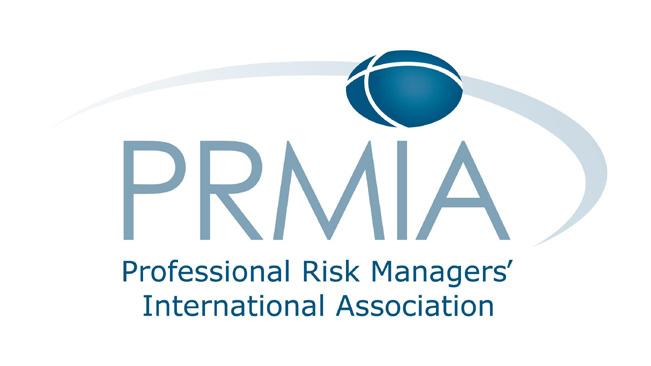
INTELLIGENT RISK knowledge for the PRMIA community ©2024 - All Rights Reserved Professional Risk Managers’ International Association February 2024
PROFESSIONAL RISK MANAGERS’ INTERNATIONAL ASSOCIATION
CONTENT EDITORS
Carl Densem
Risk Manager, Financial Markets, Rabobank
Steve Lindo
Principal, SRL Advisory Services and Lecturer at Columbia University

SPECIAL THANKS
Thanks to our sponsors, the exclusive content of Intelligent Risk is freely distributed worldwide. If you would like more information about sponsorship opportunities contact sponsorship@prmia.org
INSIDE THIS ISSUE
03 Editor introduction
04 Creating and sustaining a healthy risk culture by Nino Gordeladze-O’Brien
11 Guiding principles for enhancing operational risk stress testing by Peter Ding
15 Hedging technological (crypto) commodities by Malcolm Gloyer
21 Measuring carbon exposure in investment portfolios by Daniel Arnold
27 Banking on heightened regulatory scrutiny by Scott Freidenrich
32 Navigating the unpredictable: Insights from high reliability organizations - by Famien Konan
37 ESG and world change: the competing perspectives by Ina Dimitrieva & Elisabeth A. Wilson
43 Using portfolio diversification to hedge against high inflation by Andrei Ordine
49 What they don’t teach you at risk school by Rick Nason
52 The risk mitigation power of data for our most foundational infrastructure: The power grid by John Smithers
56 Basel III compliance with securities financing transactions by Edward Bace
61 Why a low birth rate may be the biggest risk of all by Carl Densem
66 Tokenization: A risk and accounting paradigm change by Peter Hughes



FIND US ON prmia.org/irisk @prmia
Intelligent Risk - February 2024 02
editor introduction
 Carl Densem Editor, PRMIA
Carl Densem Editor, PRMIA
Our first issue of 2024 demonstrates the diversity of areas of expertise which comprise the Intelligent Risk community. Our Capstone article focuses on risk culture, that hardto-define and increasingly important foundation for any organization’s thriving. It is also a primary focus of banking regulators, who are wary of 2023’s bank failures repeating. In Creating and Sustaining a Healthy Risk Culture, Nino Gordeladze-O’Brien explores the traits of healthy risk cultures and how to spot one in the wild. She points out that critical to practitioners this year will be supervisory assessments that look at behavior because it is the “tangible manifestation of invisible culture.” Nino also looks at the roadmap to an effective risk culture, plus how to know when you’ve arrived.
 Steve Lindo Editor, PRMIA
Steve Lindo Editor, PRMIA
Staying on risk culture, you won’t want to miss Rick Nason discussing What They Don’t Teach You At Risk School. He points out the importance of sociology (how people act in groups) and psychology (how people act individually) in practising risk management. Another returning author, Famien Konan, encourages risk managers to learn from examples of resilience in other industries in Navigating the Unpredictable: Insights from High Reliability Organizations.
ESG is quite clearly being tugged in different directions, so much so that risk managers find it hard to keep up. Ina Dimitrieva and Elisabeth Wilson return to our pages with real-life examples in ESG and World Change: The Competing Perspectives. Our final highlight is of Peter Ding’s Guiding Principles for Enhancing Operational Risk Stress Testing. He outlines the regulatory background and challenges facing operational risk stress testing before setting up a common-sense, practitioner-friendly framework for going about it. You can also watch our author interview with Peter.
Top articles of 2023
In a first for Intelligent Risk we asked you, our readers, to vote on your top 3 articles of 2023 (excluding capstones). The 4 issues spanned 50 articles, so competition was stiff. The results are in! Congratulations to the following:
Top Article of 2023
Rick Nason – Does Your Risk Management Pass a Turing Test?
1st Runner-up Dr. Aakash Ramchand Dil – How A Small Oil Nation is Leading on ESG
2nd Runner-up John Thackeray – Shepherd or the Sheep: Introducing Climate Risk Frameworks
Sponsorship opportunities
Lastly, Intelligent Risk is volunteer run: our editors, authors and peer reviewers contribute our time and talents because we recognize its value. Sponsorship of the publication offers value to our sponsors and supports our ability to continue to enhance this worthwhile publication. To broaden options and offer value, two new options for potential sponsors are now available: Article Sponsorship and the Virtual Fireside Chat. These are more targeted than the existing Issue Sponsorship option. For details and to learn more about sponsorship opportunities in an upcoming issue, reach out to cheryl.buck@prmia.org
03 Intelligent Risk - February 2024

A healthy risk culture delivers many tangible benefits. Creating one starts with defining organizational culture and risk culture and developing a roadmap customized to the organization. In this article, the author explains these cultural definitions and describes the key elements of a risk culture transformation roadmap, the challenges to be expected, and the critical success factors to overcome them.
creating and sustaining a healthy risk culture
by Nino Gordeladze-O’Brien
defining organizational culture
I would like to share my insights on how organizational value can be delivered through a healthy Risk Culture at any organization, by drawing on my experiences in each of the Three Lines [of Defense] (IIA, 2020) i at systemically important/listed banks, multinational FMCG1 companies and the Big Four accounting firms in both developed and developing economies.
First, let us align on the understanding of Organizational Culture, which often is perceived to be amorphous and nebulous. For simplicity, I propose to refer to it as “the way we do things around here”, or even better “what we do, when no one is looking” (Miles, 2021) ii. According to the UK’s Financial Services Culture Board, “understanding a firm’s culture matters, because it is fundamental to the way in which a strategy agreed in the boardroom actually takes effect” (FSCB, 2018).
By now, it is commonly understood that unhealthy culture has been the root cause of corporate failures for decades internationally – from Enron’s 2001 accounting fraud to the most recent Silicon Valley Bank and Credit Suisse scandals in 2023. The multitude and the diversity of these institutional failures has resulted in the loss of public trust in the financial sector, the accounting profession and even the regulators’ ability to prevent their occurrence. Consequently, regulatory focus has been growing in this space. According to Bank of England’s (BoE) research, “robust evidence” was found, that “poor culture leads to substantially higher [banking] risk, demonstrating the importance of bank culture for prudential outcomes” (Joel Suss, 2021) iii. Other regulators, including De Nederlandsche Bank (DNB), European Central Bank (ECB), Australian Prudential Regulation Authority (APRA) and the Federal Reserve Bank of New York (NY Fed) share this view.
CAPSTONE ARTICLE Intelligent Risk - February 2024 04
Synopsis 1 / Fast Moving Consumer Goods
Poor culture is often better understood than “healthy culture”. Fortunately, the UK’s Financial Conduct Authority (FCA) comes to our aid by noting that “healthy cultures are purposeful and they are safe” (FCA, 2020iv , where the former criterion refers to an organizational purpose beyond the business model and profitability, and the latter highlights the significance of psychological safety at organizations, i.e. environments where employees are not worried about negative consequences when raising concerns. Another important factor, identified by regulators as being instrumental for reducing misconduct, is cognitive diversity – the term, which goes beyond the conventional diversity metrics around gender, ethnicity and social backgrounds, rather denotes different styles of thinking, information processing and perspectives, overall contributing to the improved collective problem-solving at the institution (Miles, 2021)v .
key elements of risk culture
This brings us to defining Risk Culture as a subset of overall organizational culture, which is specific to the way people think and behave about managing risk. Effective Risk Culture plays a key role in delivering overall healthy Organizational Culture. According to the results of ACCA’s global survey “Risk Culture: Building Resilience and Seizing Opportunities” (Johnson, 2023)vi, where around 2,000 risk leaders responded from across the world, “a good risk culture is an organizational culture that gives staff the capacity to spot emerging risks and act on them”. On the other hand, ECB notes that “risk culture is a set of norms, attitudes and behaviors related to awareness, management and control of risks in a bank. It shapes [staff’s] day-to-day decisions and has an impact on the risks they take.” (ECB, 2023)vii Frank Elderson (the vicechair of ECB’s Supervisory Board) highlighted the importance of culture and behavior assessments as part of ECB’s overall supervisory assessment process, in his September 2023 speech. He further noted, that “behavior is the tangible manifestation of invisible culture”, and that “it is directly observable, while culture is not” (Frank Elderson, 2023)viii. Assessing behavior as part of organizational/risk culture supervisory reviews is the approach first introduced by DNB (the Dutch regulator) in 2010ix, and since has been considered by other regulators around the world.
Bearing in mind the increased stakeholder focus on healthy Risk Culture, it would help to understand what the target Risk Culture looks like at an organization and the effort required to achieve it.
To make Risk Culture more tangible, let us break it down into four key elements (in no particular order of significance):
1. Purposeful Culture and Risk Leadership
The first element entails defining what “purposeful culture” means for an organization and the role Risk Management needs to play in helping fulfil this purpose. It covers “Tone at the Top” as well as “Tone from Above” – i.e. line manager’s behavior as one of the key influencers on employees’ behavior. Also, it includes an “Openness and Challenge” component, which encompasses psychological safety and moral courage to speak-up i.e. anti-bystanding behavior.
05 Intelligent Risk - February 2024
2. Governance & Decisions
The second element includes allocating and agreeing risk management related accountabilities and responsibilities across the Three Lines (IIA, 2020). Although it is commonly accepted that “risk management is everyone’s business”, ECB’s report (ECB, 2023)x highlights a number of improvement opportunities in this area and demonstrates the need for further effort. The second element also covers “Transparency and Reporting”, where a strategically aligned risk appetite framework is cascaded to all operations and is used as a risk-taking guide for day-to-day decision-making. Ideally, any deviations from set tolerances are timely responded to and escalated to relevant stakeholders within and outside the organization. Finally, to achieve a healthy Risk Culture, business decisions must be long-termist and supported by reward and incentives schemes to facilitate intended risk behavior (ECB, 2023).
3. The third element is “Competency”, which includes risk awareness, skills, knowledge and risk resources.
4. The fourth element “Systems and Controls” encompasses risk systems, processes and controls.
In general, the last two elements are there to support those individuals who are willing to “do the right thing”, by providing them with a common risk taxonomy and tools across the organization. They help improve communication between the key stakeholders and help them agree on mutual expectations and priorities around risk management.
roadmap to implementing a healthy risk culture
The following are seven phases of a healthy Risk Culture implementation (or enhancement) program:
1. Perform Risk Culture Diagnostic – this could be performed by utilizing a combination of various methods, including employee surveys and interviews (both focused on collecting observed behaviors rather than opinions), direct observation and analysis of staff behavior, specific tools available on the market (including Barrett’s “Cultural Values Assessment” model (BVC, n.d.)xi, Risk Type Compass (PCL, n.d.) etc., analysis of internal data and information (including customer complaints, regulatory letters, control function and assurance provider reports, incident trend analysis, employee concerns via various channels, etc.
2. Re-imagine the Target State in line with the Business Strategy for both mid- and long-term horizons.
3. Perform Gap Analysis.
4. Develop a Risk Culture strategy and a detailed Implementation Roadmap addressing the root causes of findings in the Diagnostic phase.
5. Obtain Board and management commitment for long-term support (cultural transformation could take
06 Intelligent Risk - February 2024
between 3-5 years to show any tangible results), including a budget which reflects sourcing core team members with diverse capabilities, as well as tools and systems required for an organization-wide Risk Culture strategy implementation.
6. Execute the detailed Roadmap via a phased approach by recruiting and onboarding the team, while sourcing and implementing required tools and systems. Considering the cross-functional nature of a Risk Culture transformation project, it is important to agree shared deliverables aka “key business objectives” with key stakeholders. Maintaining ongoing communication with them will provide a continuous feedback loop and opportunities to fine-tune the implementation Roadmap.
7. Periodically review, re-validate and update the Risk Culture transformation strategy and Roadmap to ensure they remain relevant in the light of changing circumstances or the business strategy.
key challenges to implementing a healthy risk culture
Below are some of the key challenges to anticipate when embarking on a Risk Culture transformation journey:
1. “One size-fits-all” approach even within the organization does not work, because often the degree of change required and employees’ readiness to change varies across the organization, while the analysis to understand this uneven terrain is frequently not undertaken, sometimes due to lack of insights and/ or tools.
2. Resistance to organization-wide change - as noted earlier, human behavior determines how healthy or unhealthy culture is formed. Human behavior itself is influenced by biases which are difficult to change. Another reason for resisting the transformation could be culture program fatigue, especially in the post-pandemic world, where many organizations have experimented with multiple modes of work and other cultural change initiatives driven by the changing operating circumstances. Also, if Risk Culture transformation is perceived to be superficial, a mere branding exercise, then it will not be supported by the critical mass of employees.
3. Difficulty in measuring culture – conventional indicators (such as training attendance rates, Net Promoter Scores, unconscious bias testing) do not actually measure culture, so it is difficult to quantify the current state of Risk Culture as well as to track progress.
4. Most organizations are likely to face conflicting stakeholder expectations and needs, consequently, the ability to manage these effectively will influence the success rate of this transformation initiative.
5. Due to competing organizational priorities, there might be difficulties in prioritizing Risk Culture initiatives.
6. According to DNB’s insights (DNB, n.d.), boards often lack expertise in behavior and culture, leaders do not sufficiently abide by the values that they endorse, and proposed measures are insufficient to achieve intended change.
07 Intelligent Risk - February 2024
critical success factors
To overcome the above challenges, the following are some of the critical success factors to aim for:
1. Strong sponsorship and advocacy both at the top and mid-level management is the driving force for any change initiative, especially the long-term cultural one. Observable leadership behavior is one of the strongest influencers to drive organizational change, this is where “walking the talk” really makes a difference. Also, it is helpful to identify and engage change champions and influencers across the organization. These may be individuals who have been with the organization for a considerable amount of time and have earned the respect and trust of their peers.
2. Tailored approach to change – gaining a comprehensive understanding of the organizational landscape in terms of the degree of culture change required and the employee readiness to change, perhaps assisted by behavioral science tools, could help identify those areas in the organization where the likelihood of transformation success is higher. Successful use cases also help with faster and more effective rollout of the change program to the rest of the organization.
3. Understanding and addressing the root causes of weaknesses identified during the Risk Culture diagnostic phase (noted earlier). Actions targeting these should be included in the detailed Implementation Roadmap (above).
4. Understanding key interdependencies across the organization and forging cross-functional commitment to support Risk Culture transformation initiatives - these could include identification of existing gaps and/or weaknesses in the processes, systems and capabilities critical for the success of the Risk Culture transformation program, and agreeing timely resolution plans with relevant stakeholders.
5. Developing new management information systems to assess culture outcomes – including meaningful forward-looking indicators (such as those developed by Bank of England (Joel Suss, 2021)xiii , inventorizing and understanding staff behaviors, with the support of various behavioral science tools. For example, Barret’s “Cultural Values Assessment” modelxiv helps identify “norms and values” at an organization as well as underlying “assumptions and beliefs” that may be driving staff behavior. Applying this tool over time could show cultural evolution and could help tailor further efforts in addressing the lagging areas.
6. Rewarding and incentivizing target [risk] behavior top-down - this could include balancing performance scorecards for both performance metrics and prudent risk-taking behaviors, aligning KPIs with the organization’s risk appetite, and applying malus and clawback clauses in case of excessive risk-taking or misconduct (ECB, 2023)xv .
08 Intelligent Risk - February 2024
conclusion
Overall, effective Risk Culture drives healthy Organizational Culture, which delivers many tangible benefits, such as shifting the mindset from reactive to proactive risk management, building organizational capability and enhancing staff resilience to change, improving social engagement, reducing reputation risk, meeting regulators’ expectations and as a result reducing fines and/or capital charges, and most importantly –improving public trust. With so many benefits on offer, there’s no reason not to embark on a Risk Culture transformation journey today.
references
i. The Institute of Internal Auditors (2020, July). THE IIA’S THREE LINES MODEL
An update of the Three Lines of Defense. https://www.theiia.org/globalassets/documents/resources/the-iias-three-linesmodel-an-update-of-the-three-lines-of-defense-july-2020/three-lines-model-updated-english.pdf
ii. Miles, R. (2021). Culture Audit in Financial Services: Reporting on Behaviour to Conduct Regulators
iii. Joel Suss, D. B. (2021, March). https://www.bankofengland.co.uk/working-paper/2021/organisational-culture-and-bankrisk - :~:text=We%20use%20this%20data%20to,bank%20culture%20for%20prudential%20outcomes
iv. Financial Conduct Authority, Discussion Paper DP20/1 (2020, March). Transforming culture in financial services, Driving purposeful cultures. https://www.fca.org.uk/publication/discussion/dp20-1.pdf
v. Miles, R. (2021). Culture Audit in Financial Services: Reporting on Behaviour to Conduct Regulators
vi. Johnson, R. (2023, April). Risk Culture: Building Resilience and Seizing Opportunities, A Global Survey and Report. https:// www.accaglobal.com/content/dam/ACCA_Global/professional-insights/riskculture/PI-RISK-CULTURE%20v8.pdf
vii. European Central Bank (2023, February). Strong risk culture — sound banks. https://www.bankingsupervision.europa. eu/press/publications/newsletter/2023/html/ssm.nl230215_3.en.html#:~:text=Risk%20culture%20is%20a%20set,on%20 the%20risks%20they%20take.
viii. Elderson, F. (2023, September). Speech: Treading softly yet boldly: how culture drives risk in banks and what supervisors can do about it. https://www.bankingsupervision.europa.eu/press/speeches/date/2023/html/ssm.sp230919~589c61455b. en.html
ix. De Nederlandsche Bank, editor Raaijmakers, M. (2015). https://www.dnb.nl/media/1gmkp1vk/supervision-of-behaviourand-culture_tcm46-380398-1.pdf
x. European Central Bank (2023, February). Strong risk culture — sound banks.
xi. Barrett Values Centre. https://www.valuescentre.com/
xii. PCL Psychological Consultancy. https://www.psychological-consultancy.com
xiii. Joel Suss, D. B. (2021, March). https://www.bankofengland.co.uk/working-paper/2021/organisational-culture-and-bankrisk - :~:text=We%20use%20this%20data%20to,bank%20culture%20for%20prudential%20outcomes
xiv. Barrett Values Centre. https://www.valuescentre.com/
xv. European Central Bank (2023, February). Strong risk culture — sound banks. https://www.bankingsupervision.europa. eu/press/publications/newsletter/2023/html/ssm.nl230215_3.en.html#:~:text=Risk%20culture%20is%20a%20set,on%20 the%20risks%20they%20take
09 Intelligent Risk - February 2024
peer-reviewed by
Steve Lindo
author
Nino Gordeladze-O’Brien

Nino’s 19 years career in risk management spans across systemically important listed banks both: in emerging and developed markets, the Big Four Consulting (EY, KPMG) and listed multinational companies in Australia. Nino accumulated unique experience in each of the Three Lines [of Defense] as well as external assurance providers granting her a broad perspective on important risk management and internal control matters.
Most recently, Nino founded GRC Consulting, focusing on Governance, Risk, Compliance, Internal Audit and ESG themes.
As Head of Enterprise Risk Management (ERM), Nino led the creation of the first ERM function at Bank of Georgia, the London Stock Exchange listed systemically important bank in Georgia. This entailed strengthening the Risk Culture and the effectiveness of the Three Lines [of Defense] Model across the organization.
In her previous role as the Chief Audit Executive/Head of Internal Audit at the company, Nino modernized the Internal Audit function and influenced the introduction of many innovative, advanced risk management frameworks throughout the Group. These experiences gave Nino in depth understanding of business processes, covering key risks and controls across a broad spectrum throughout the Group.
Prior to relocating from Australia, Nino held senior risk management roles in both 1LOD and 2LOD at Westpac Banking Corporation (the second largest bank in Australia) based in Sydney.
Nino is recognized as a thought leader and a keynote speaker at various international risk management professional events, platforms and publications.
10 Intelligent Risk - February 2024

This article highlights challenges facing operational risk stress testing and emphasizes the importance of universal guiding principles. The article outlines typical stress test phases and introduces overarching principles. It emphasizes the need to transform narrative stories into quantifiable stress scenarios and address low-frequency, high-impact risks. Applying these principles can enhance stress testing programs, help organizations identify hidden risks and improve risk management.
guiding principles for enhancing operational risk stress testing
by Peter Ding
introduction
The demand for rigorous stress testing within operational risk has witnessed a significant surge, primarily driven by intensified regulatory scrutiny and heightened interest from bank boards and senior management. The shift from the AMA (Advanced Measurement Approach) to the Basel III - SA (Standardized Approach) for operational risk capital calculation has also underscored the critical role of quantitative stress tests in evaluating and confirming the adequacy of capital calculated under the SA framework.
AMA and SA background
The AMA approach, while technically risk-based, encountered significant challenges due to the absence of standardized methodologies, the arbitrary nature of scenario selections, and the subjectivity in determining the severity of chosen scenarios. These limitations led to capital calculations that lacked consistency and comparability across different institutions, creating avenues for regulatory arbitrage. In contrast, the newly introduced SA approach prioritizes enhanced standardization by implementing uniform methodologies and parameters. Nevertheless, it departs from a purely risk-based approach, placing greater emphasis on a bank’s operating size in its calculation.
Consequently, how can banks ascertain and substantiate the adequacy of the SA calculation to cover their operational risks? Stress testing emerges as a valuable tool, perhaps one of the few available, to tackle this question. It can effectively address whether the capital amount determined via the SA approach is sufficient. Moreover, stress testing can serve the critical purpose of identifying potential capital shortfalls and assessing the need for additional Pillar II capital add-ons.
Intelligent Risk - February 2024 11
Synopsis
challenges facing operational risk stress testing
Stress testing methodologies frequently encounter hurdles and even resistance in terms of their outcomes. The challenges that operational risk managers continually confront can be attributed, in part, to the pervasive nature of operational risks, data constraints, the lack of standardized modeling approaches and result benchmarks, and communication gaps among stakeholders. Although there’s no one-size-fits-all solution that can completely resolve these challenges, the establishment and adoption of universally applicable guiding principles could substantially enhance the quality of stress testing analysis, and in turn elevate stakeholder acceptance and overall effectiveness of stress testing programs.
A typical stress testing exercise involves three phases and addresses three key questions.

The principles that will help guide us through these phases are discussed in the next section.
overarching principles
Principle 1: Adversity, not BAU. The primary objective of stress testing is to assess the bank’s resilience in the face of unexpected or extreme scenarios. In contrast to business-as-usual forecasts or budgets, which focus on predicting likely outcomes within the regular operating environment, stress testing is designed to evaluate potential losses stemming from improbable yet plausible situations.
Principle 2: Types of Hypothetical Stress. Stress testing can be based on either a hypothetical operating environment or the occurrence of hypothetical risk events. For instance, stress assumptions may involve heightened intensity or frequency of cyber threats or the assumption of a successful attack on specific systems. If the stress test pertains to the operating environment, a robust mechanism should be established for translating the stressed environment into probabilities of risk events.
Principle 3: Translate the Narrative. A narrative storyline or high-level topic may serve as an initial concept or starting point, however a narrative description alone is insufficient to enable effective stress testing analysis. To conduct a comprehensive assessment and allow for precise quantification, it is imperative to translate such a narrative into a well-defined stress scenario than can be presented with quantifiable and measurable factors.
12 Intelligent Risk - February 2024
Principle 4: Importance of Data. The prevalence of unavailable data and incomplete, inconsistent data poses a frequent challenge in operational risk assessment. To surmount these data-related obstacles and enhance the accuracy and reliability of the stress testing analysis, it is crucial to leverage a comprehensive data management approach, including making the most of the data at hand, supplementing it with external sources and references, consulting subject matter experts (SMEs) for their insights, building assumptions that can withstand scrutiny and maintaining the adaptability and resilience of parameters.
Principle 5: Correlations Change. In a hypothetical stressed situation, the dynamics between various variables can undergo substantial changes, and the typical cause-and-effect, input-output, or revenue-cost relationships may become disrupted. Placing excessive reliance on historical facts and relationships that have been observed within a business-as-usual (BAU) context can be ineffective or misleading. Therefore, it is necessary to approach stress testing with a fresh perspective, recognizing the likely broken relationships and applying robust overlays to account for these changes.
Principle 6: Reputational Impact. Assessing the implications for customer loyalty and reputation can be a complex task due to their intangible nature. However, it’s crucial to recognize that these aspects can carry substantial financial consequences over the long term. Negative impacts on customer loyalty and reputation may lead to reduced customer retention and decreased market share. Therefore, there is a need to explore innovative approaches to devise reasonable methods for translating the impact of these intangibles into financial loss estimation.
Principle 7: Lesser-Known Operational Risks. Operational risks can be categorized into four distinct groups based on their frequency and impact, as illustrated in the following chart. High-frequency risks are typically well-identified and closely scrutinized during routine risk assessments, receiving the attention they deserve. In contrast, low-frequency risks present a challenge in terms of detection within standard monitoring practices. Moreover, historical loss data often lacks sufficient information about low-frequency risk events, which can lead to their underestimation or neglect. However, significant surprises often arise from low-frequency, high-impact risks. Therefore, low frequency risks, especially those with a potential for high impact, should not be overlooked or given insufficient consideration.
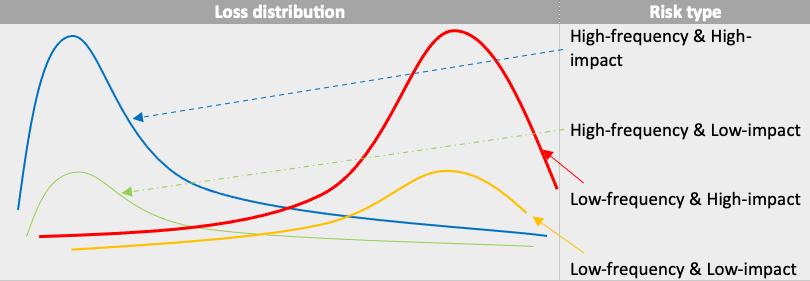
13 Intelligent Risk - February 2024
Figure 1: Type of Operational Risk Loss Distribution
conclusion
Through the application of these fundamental principles in the design and implementation of stress tests, organizations can significantly enhance the quality and effectiveness of their stress testing programs. Effective stress tests play a pivotal role in uncovering overlooked risks that might go unnoticed in routine operations and risk monitoring, thereby reducing the potential for unexpected surprises and enhancing the organization’s readiness for adverse situations. Furthermore, a well-structured stress testing program can contribute to the refinement of an organization’s risk appetite and risk tolerance framework, making them adaptable and relevant in both normal and challenging circumstances.
peer-reviewed by
Jammi Rao
author
Peter Ding

Has over 20 years’ experience in banking industry, including extensive involvement in commercial lending, corporate financial service, Basel implementation and risk management. For the recent 10 years, having been focused on risk analysis and modelling and developed various models for risk rating, credit decisioning, capital calculation, liquidity assessment, stress testing and quantification of financial and non-financial risks. Holder of MBA degree in Finance and the PRM designation.
14 Intelligent Risk - February 2024
Synopsis
This article discusses synthetic exposure to financial assets that simulates purchasing an option on the underlying cryptocurrency asset without using derivatives as an alternative to asset allocation-based cryptocurrency research. The approach uses the basic Black-Scholes pricing model and Hull’s delta hedging algorithm, replicating the trend in financial assets with observable market inputs. This provides a valuable comparison for practitioners allowing them to draw robust inference that is likely to persist over time.
hedging technological (crypto) commodities
by Malcolm Gloyer

With an exploding literature on crypto, many papers focus on asset allocation and the third central moment or “skewness” (Ang et al., 2022)1 despite Markowitz recognising in 1952 that “the third moment of the probability distribution of returns from the portfolio may be connected with a propensity to gamble 2.” Positive portfolio contributions are unlikely to persist if these “can be attributed to rebalancing gains due to capitalizing on high excess quarterly returns on cryptocurrencies and, in opposite, due to topping-up the allocation to cryptocurrencies following their low quarterly returns relative to other asset classes”3
While volatility scaling and trend-following models have a successful history, is sufficient data really available for anyone to conclude that “the cash-crypto portfolio with equity-like volatility has fewer downside tail events and much lower volatility of volatility than the S&P 500 portfolio over our short historical sample”?4. Given the short period of availability, high volatility and non-stationarity of cryptocurrency returns, how can risk managers draw robust inference that is likely to persist over time?
comparing gold and bitcoin
Historically, gold has frequently been used as a token that creates its own financial network. Given its limited industrial use, gold’s value has come from being accepted across most national currency networks. In contrast to most other tokens, Bitcoin has a hard stop at 21 million units 5, potentially analogous to the 244,000 metric tons of gold that represent estimated total world gold discovered to date (extracted and known underground reserves) 6. However, different stochastic price patterns limit comparative analysis between gold and Bitcoin asset classes.
introduction
Intelligent Risk - February 2024 15
One novel approach is to model gold futures and Bitcoin using dynamic hedging without options, then compare the model’s success (using quarterly returns of each of the 44 replicated options simulated from mid-2011 to date) against unhedged gold futures and Bitcoin price returns. The idea is to replicate the option’s pay-off diagram. Similarities in the shapes of the plots demonstrate commonality in gold and Bitcoin historical prices.
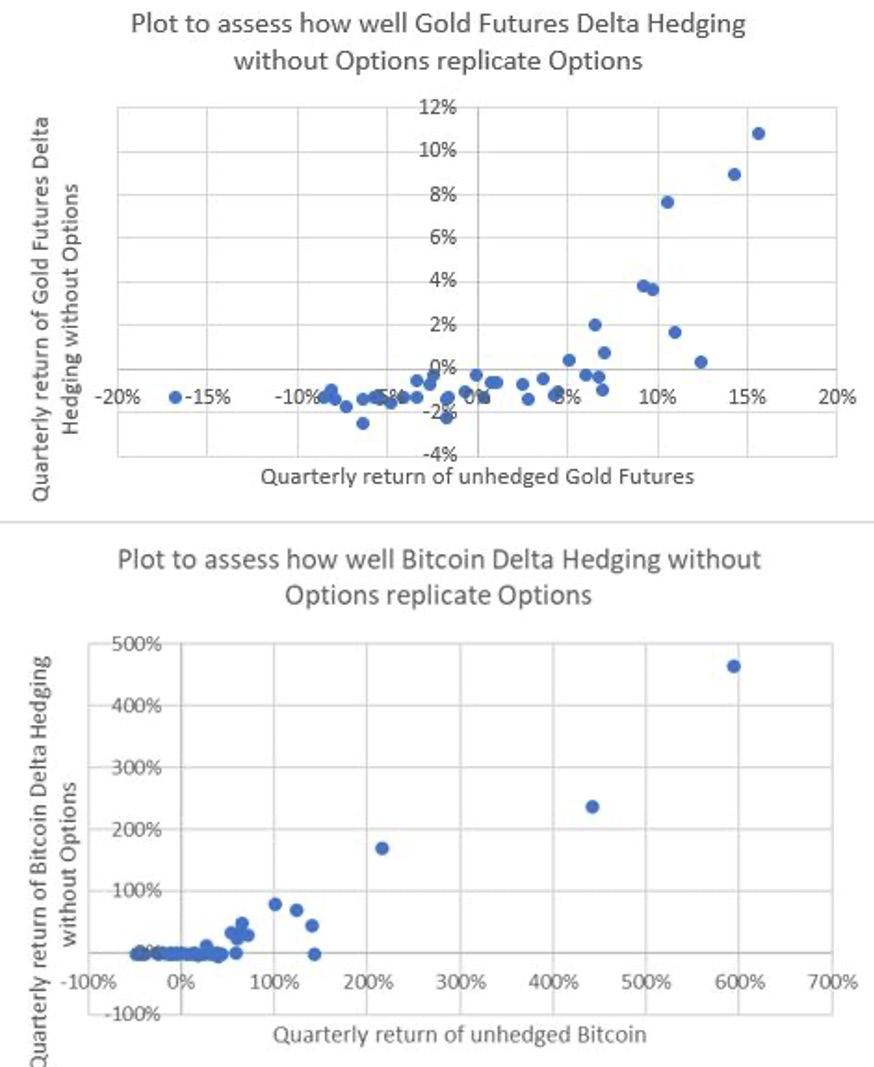
16 Intelligent Risk - February 2024
Figure 1: Plots comparing gold and Bitcoin delta hedging without options to profile of option pay-off
An alternative approach to comparing gold with Bitcoin is to model gold futures and Bitcoin using dynamic hedging without options before assessing each model’s success in capturing underlying asset upside. To do this, we look at plots of the sequential quarterly returns of replicated options against unhedged gold futures and Bitcoin returns. A similar percentage of upside capture under different market conditions demonstrates commonality in the response of gold and Bitcoin historical prices when applied to a dynamic hedging without options model.
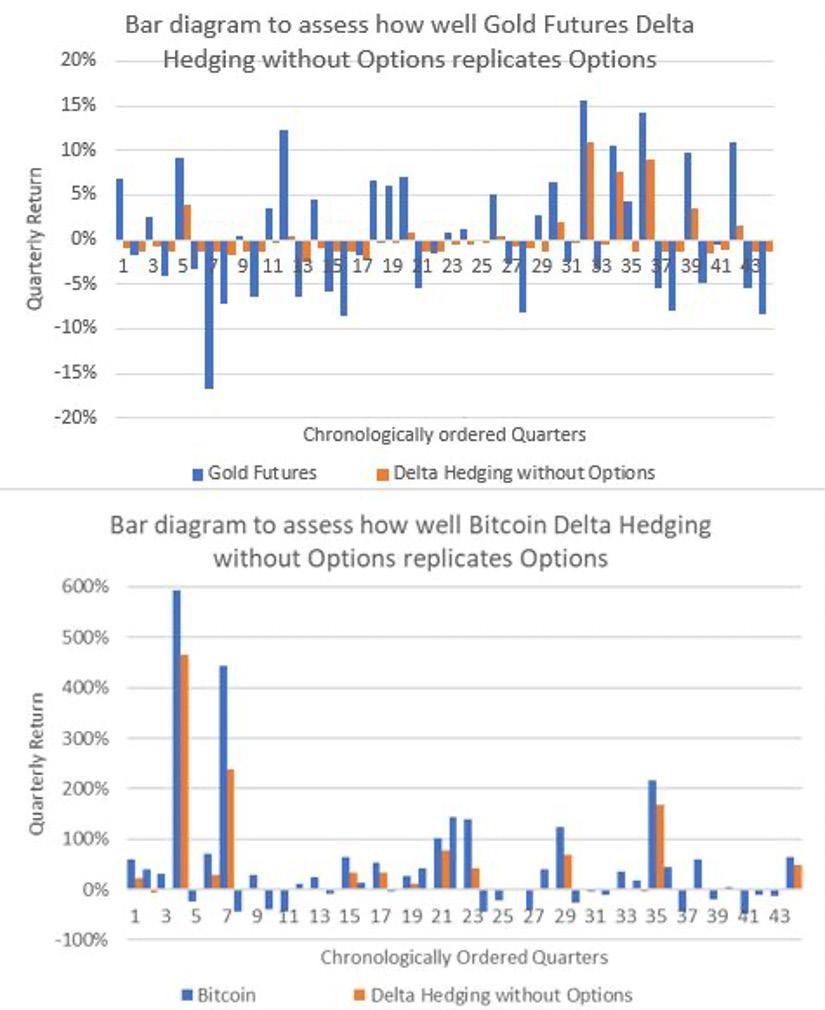
17 Intelligent Risk - February 2024
Figure 2: Upside capture plots for gold futures and Bitcoin delta hedging without options
comparing oil and ethereum
Ethereum dominates a group of native coins on blockchains that facilitate smart contracting, allowing users to send crypto assets not just to other users (as they can do with Bitcoin) but also to algorithms which enable functionality like decentralised exchanges. Such cryptocurrencies are similar to oil in a way, as both are instrumental in the creation of value or wealth elsewhere in the economy. This similarity results in Ethereum and oil being a worthwhile comparison. Oil futures and Ethereum can be modelled using dynamic hedging without options and the models’ success judged by how well the return plots replicate the option pay-off diagram.
 Figure 3: Plots comparing oil futures and Ethereum delta hedging without options to option pay-off profile
Figure 3: Plots comparing oil futures and Ethereum delta hedging without options to option pay-off profile
18 Intelligent Risk - February 2024
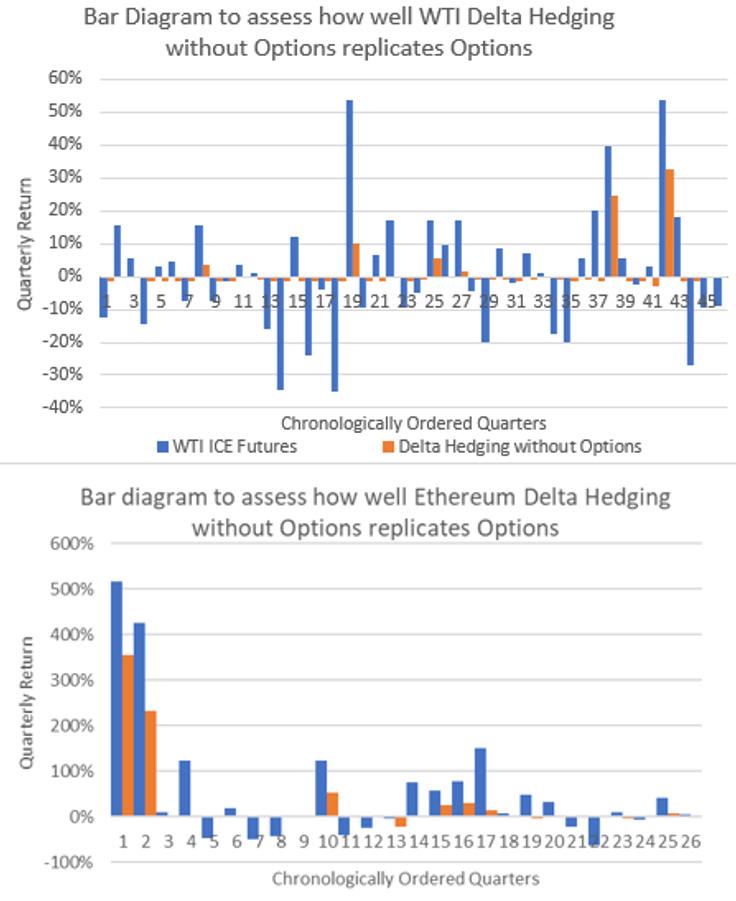
19 Intelligent Risk - February 2024
Figure 4: Upside capture plots of oil futures and Ethereum delta hedging without options
Simulated delta hedging trading strategies that take a position in cash and an underlying asset proportional to the hedge ratio of a synthetic option provide a way of comparing cryptocurrencies to more traditional asset classes. Risk managers can draw inference from similar patterns in synthetic option pay-off diagrams and underlying asset upside capture that are likely to persist over time.
As delta hedging is based on Black-Scholes, extensions to this model may be included like the volatility smile and fat tails in the underlying asset, but the strategy in turn suffers from known Black-Scholes limitations, such as assuming no arbitrage opportunities and that asset returns follow a lognormal pattern, thus ignoring large price swings that are observed more frequently in the real world.
references
i. Ang, A., Morris, T., Savi, J. (2022). Asset Allocation with Crypto: Application of Preferences for Positive Skewness. SSRN. https://ssrn.com/abstract=4042239
ii. Markowitz, H. (1952). Portfolio Selection. Journal of Finance, 7:77-91.
iii. Sepp, A. (2023). Optimal Allocation to Cryptocurrencies in Diversified Portfolios. SSRN https://ssrn.com/abstract=4217841
iv. Harvey, C.R., Zeid, T.A., Draaisma, T., Luk, M., Neville, H., Rzym, A. and Hemert, O.V. (2022, June 2). An Investor’s Guide to Crypto. SSRN. https://ssrn.com/abstract=4124576
v. Nakamoto, S. (2008). Bitcoin: A Peer-to-Peer Electronic Cash System. ResearchGate. Bitcoin: A Peer-to-Peer Electronic Cash System (researchgate.net)
vi. U.S. Geological Survey. How much gold has been found in the world? U.S. Department of the Interior. How much gold has been found in the world? | U.S. Geological Survey (usgs.gov)
peer-reviewed by
Carl Densem
Malcolm Gloyer

As a Certified Practicing Project Manager (CPPM MAIPM), Malcolm has more than 30 years’ experience working on projects in the UK and Australia, specializing in market risk, derivatives and commodities. Malcolm has worked as a consultant at companies including Bank of America Merrill Lynch, London Metal Exchange, Nomura, ABN Amro, EDF Trading, Santander and Lloyds Bank and has been a guest lecturer at several universities. Malcolm has had articles published in professional investment magazines and has written several eBooks.
conclusion
author
20 Intelligent Risk - February 2024

Synopsis
Index providers, fund managers and investors in financial assets are increasingly feeling the need to measure their portfolios’ carbon exposure. However, existing metrics are both inconsistent and lacking in reliable data. This article explains and compares the characteristics of carbon exposure measurement methods which are currently available for financial assets.
measuring carbon exposure in investment portfolios
by Daniel Arnold
Measuring and accounting for carbon exposure in a portfolio is a key metric for investors seeking to manage or reduce their carbon exposure. International organisations including the Partnership for Carbon Accounting Financials i (PCAF) and Task Force on Climate-Related Financial Disclosures ii (TCFD) have developed standards that investors can leverage. Equally important to the standards is the need for them to be applied with consistency and transparency. To avoid confusion when comparing investments, clear labelling and understanding of the differing metrics is required.
There are three ways that confusion and false comparisons can occur without careful disclosure and description of the data.
• International organisations define an asset’s Carbon Intensity (CI) and a portfolio’s Weighted Average Carbon Intensity (WACI) in Carbon Emission tons CO2e/$M Revenue. We observe demand for other CI variants that use divisors including Enterprise Value Including Cash1 (EVIC), Total Sales, or Unit Production based measures. Each method has benefits and disadvantages, but they are not comparable.
• Portfolio WACI is time sensitive. When comparing different portfolios, the same date and CI method must be used.
• Distributing and accumulating fund share classes will have diverging emission levels due to the reinvestment of dividends. Carbon targets are harder to meet for accumulating share classes. We find it is preferable to use Financed Emissions to measure the change in carbon over Inflation Adjusted WACI or WACI.
Intelligent Risk - February 2024 21 1 / Also labelled Carbon Footprint by TCFD and Green House Gas (GHG) Intensity in EU Benchmark Regulation
comparing portfolios’ current carbon exposure
When assessing a fund or index’s carbon profile we believe investors have two key questions: (1) How does the carbon exposure of the portfolio compare to other potential portfolios, and (2) Have carbon reduction targets been met.
WACI is the best metric to compare a portfolio’s carbon exposure at a single point in time. For an accurate comparison, timeliness and consistency of the metric are key. The methods used to calculate Carbon Intensity can be broadly grouped into asset-based (typically EVIC) or fundamental- based (revenues/sales).
Asset-based measures offer the advantage of ensuring full allocation of carbon across the assets of the company. They are, however, subject to higher variability due to price moves. Fundamental-based measures offer more stable intensities, but over or underestimate carbon based on dollar value invested. Taking MSCI World Index an example, the EVIC WACI is circa 45 vs a Revenue WACI of 105. Unless defined otherwise, this article will focus on EVIC WACI.
As with bond yields, EVIC WACI has an inverse relationship to its divisor. Given the volatility in equity markets, EVIC WACI data from days apart will vary considerably and are not comparable. It is also important that the date for the EVIC WACI data is the same as for the holdings/weights of the portfolio.
The period 2022 - 23 highlights the relative movement of Carbon Intensities. During this period the Total Carbon of MSCI World Index has remained essentially flat, but the EVIC WACI has ranged between 42 and 54, representing a 30% increase from low to high. Revenue WACI exhibited a similar range, but with the metrics moving in opposite directions over the test period.
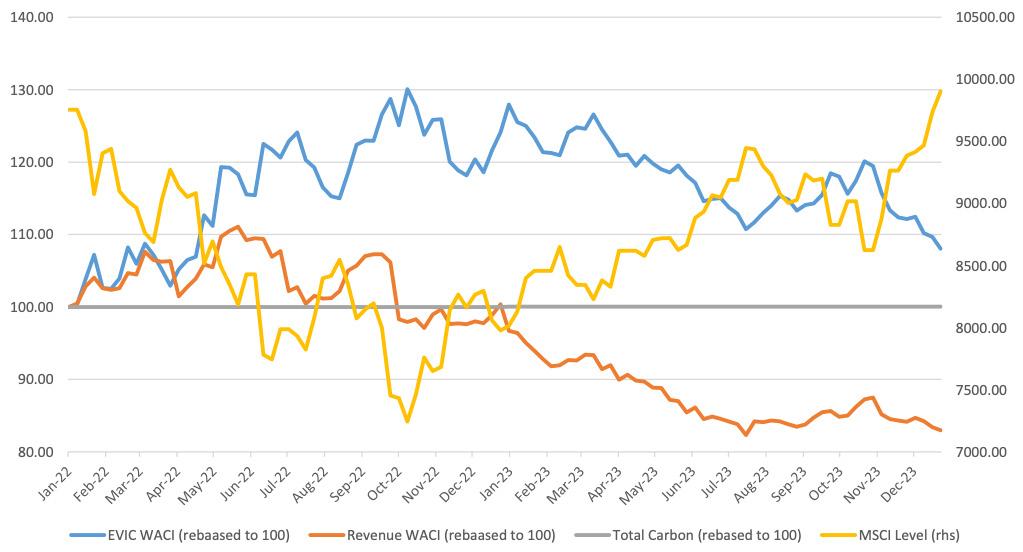
22 Intelligent Risk - February 2024
Figure 1: Variability of Rebased Carbon Intensity Over Time (Source: Deutsche Bank, Factset, MSCI)
As WACI is sensitive to both asset prices and the asset measure, investors need equivalent data to compare the carbon exposure of potential investments. A comparable situation exists in fixed income, where an investor would not compare a bond’s treasury spread today with another asset swap spread from a week ago. Beyond the calculation, carbon emission data continues to be an emerging data set. Whilst many companies provide detailed reporting, the reported methodology behind data points is not always consistent. Other companies currently do not report, which requires the calculation of estimates or exclusion of these companies from the portfolio reporting.
comparing different methods for analyzing changes in carbon exposure
When measuring a portfolio’s carbon exposure over time, the metrics must accurately track the actual exposure change and not be skewed by unrelated factors. Total Carbon, defined as the simple summation of all the stocks’ emissions, offers a simple metric, but it is not representative of the portfolio’s actual investments. Where a carbon reduction target is implemented, such metrics should align with the decarbonization target to avoid greenwashing scenarios.
WACI is not an appropriate metric, given that it is a ratio that has direct variability to price movements. This means a comparison between two dates does not inform us about the actual change in carbon output.
Financed Emissions as defined by PCAF and Total Carbon Emissions as defined by TCFD are equivalent metrics which aim to measure the carbon output of the portfolio. This is achieved by proportioning the companies’ carbon emissions to each holding in the portfolio and summing this result, essentially sharing the portfolio of companies across all the investors. This is a clear metric that allows an investor to track the evolution of their investments’ carbon exposure. For funds, the Financed Emissions per fund unit allow analysis that excludes the impact of up or down-sizing of the total investments.
The EU Benchmark Regulations’ Low Carbon benchmarks reference a modified Inflation Adjusted Green House Gas (GHG) Intensity to represent the benchmarks’ carbon exposure and provide a reference for cutting carbon output. The modification adjusts the current GHG Intensities by the change in EVIC, essentially adjusting for asset price inflation or deflation.
Investors face two challenges when measuring carbon exposure over time. Changes in the capital structure or pricing of equity vs debt of companies will change the carbon exposure of these elements. These changes can have a material impact on a portfolio’s carbon exposure. We believe this is an unavoidable feature of target carbon investing and will require investors to manage and explain the exposure accordingly.
Secondly, the measure must be consistent over time and reflect changes in the portfolio. Financed Emissions and Inflation Adjusted GHG Intensity offer a measure of change in carbon exposure. Our view, however, is that Financed Emissions is the superior metric as it is consistent when applied to different portfolio allocations (market cap vs equal weighted), does not require a rebasing, and accounts for reinvestment of income.
23 Intelligent Risk - February 2024
To exemplify the benefits of Financed Emissions, we tested market capitalization-based indices using market capitalization-based intensity. This measure was specifically chosen, as the divisor for both the stocks’ weight and intensity are the same, therefore the carbon output of the index is equal to the Total Carbon of the portfolio. It is thus possible to validate the metric by comparing these to the Total Carbon. The MSCI World was selected as a test index and the resultant metrics along with the Total Carbon are rebased to 100 and compared from 2012 in Figure 2.
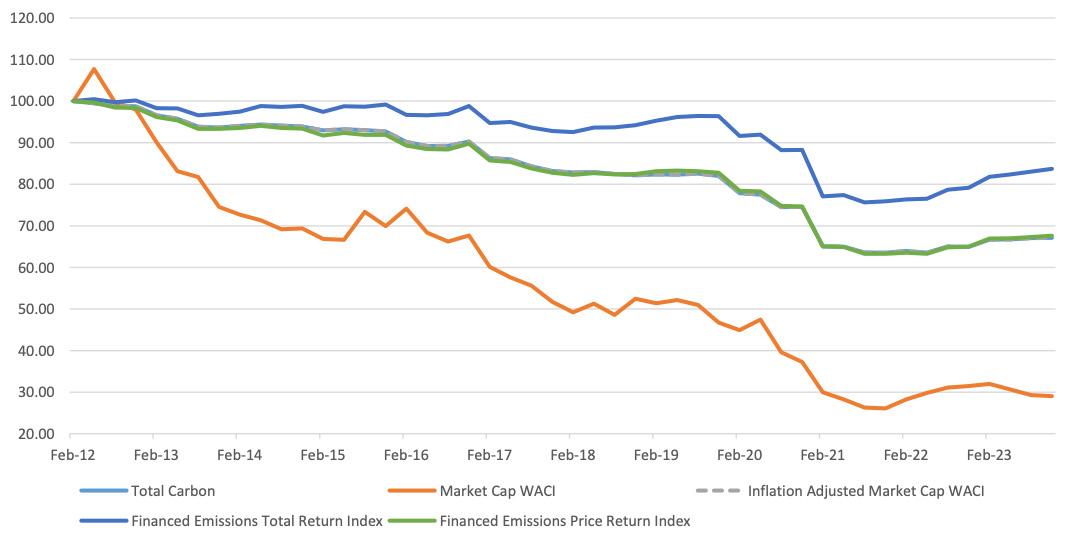
The Total Carbon, Financed Emissions Price Return and Inflation Adjusted WACI are almost identical. The Emissions Total Return is closely correlated to the Total Carbon but consistently diverges away from it. This can be attributed to the reinvestment of dividends in the index that increase the holding proportionally across the index membership. In effect, the reinvestment of cash flows increases the total value of investments and hence the carbon emissions of the index. The impact of reinvesting dividends on carbon output is a key factor that must be considered when making carbon targeted investments.
To further assess and compare the Financed Emissions and Inflation Adjusted WACI, similar analysis was performed for equal weight and equal sector weight indices (Figure 3 and 4). In these back-tests, the equivalence of Inflation Adjusted WACI and Financed Emissions PR no longer holds, with Inflation Adjusted WACI exceeding Financed Emissions TR in some periods.
Figure 2: Rebased Carbon Exposure for Market Cap index based on Market Cap CI (Deutsche Bank, Factset, MSCI)
24 Intelligent Risk - February 2024


The Financed Emissions metric is calculated using current carbon intensities and the dollar holding in each instrument, giving an accurate accounting of the carbon emissions of the portfolio.
Figure 3: Rebased Carbon Exposure for Equal Weight index based on Market Cap CI (Deutsche Bank, Factset, MSCI)
25 Intelligent Risk - February 2024
Figure 4: Rebased Carbon Exposure for Equal Sector Weight index based on Market Cap CI (Deutsche Bank, Factset, MSCI)
The Inflation Adjusted WACI relies on the rescaling of the current Carbon Intensity based on the overall change in asset values, effectively normalizing the adjustment based on the average change in asset measure. The impact of using normalized data on non-market capitalization portfolios is to skew the Carbon Intensity base adjustment results away from the Financed Emissions.
conclusion
We therefore view Financed Emissions as a better measure for assessing the true carbon change over time. Distributing (price) and reinvesting (total return) portfolios will also have different paths and therefore, to avoid divergence from the target, an asset manager/index provider may need to manage the portfolios differently. For reinvesting funds and Total Return indices the selection of Financed Emissions ensures they are targeting the appropriate carbon reduction. Financed Emissions changes, along with factors including current emission intensities, forward projections based on client commitments and credibility, are key factors when making carbon target investment decisions.
peer-reviewed by
Steve Lindo
author
Daniel Arnold

Daniel joined Deutsche Bank in 2000 and is the Head of Deutsche Bank Index Quant (DBIQ). Daniel pioneered the development of DB’s index platforms and systems, covering all asset classes, major instrument types, and investment styles. They have been used for as the underlying’s for Swaps, Notes, Certificates and ETF’s. Prior to becoming Head of DBIQ Daniel held various roles in the index team, both in London and New York. Whilst working in New York he led the development of indices used in Deutsche Bank’s US ETF platform. Daniel holds an MEng in Engineering Mathematics from the University of Bristol.
i / https://carbonaccountingfinancials.com/standard ii / https://www.fsb-tcfd.org/ 26 Intelligent Risk - February 2024
Synopsis
A string of bank failures in the first quarter of 2023 has led bank management teams, boards – and regulatory agencies – to take a closer look at institutions’ treasury risk management practices. While the bank failures may have accelerated rulemaking and introduced an era of stricter supervisory examinations, a host of other market trends is also adding urgency to banks’ enhancement of treasury risk management frameworks.
banking on heightened regulatory scrutiny
by Scott Freidenrich

Market factors including central bank interest rate actions, quantitative tightening, declining bond market liquidity and commercial real estate stress are affecting deposit levels, access to funding sources, and asset valuations. For many treasurers and chief financial officers at banks across the asset size spectrum, the game has changed1. Compliance with regulatory rules, accurate regulatory reporting, and fundamentals such as robust contingency funding plans are table stakes. Examiners expect bank management teams not only to meet the regulatory requirements but also to improve risk management practices with internal stress testing frameworks tailored to their balance sheet and business model, strong operational capabilities and sound control environments. In short, regulators are demanding that bank management teams continually improve their risk management practices and identify and remediate weaknesses faster.
The Office of Comptroller of the Currency (“OCC”) indicated its intent to have more thorough exams in its fiscal year 2024 operating plan 2.Now that the OCC’s FY 2024 has begun, banks can expect examiners to follow the priorities outlined by the OCC. Two priorities of particular interest in light of the bank failures are interest rate risk and liquidity risk management.
OCC advised examiners to “determine whether banks appropriately manage interest rate risk through effective asset and liability risk management practices 3.” OCC also noted, “Risk management should consider a robust suite of interest rate scenarios and assumption sensitivity analyses, when appropriate, as rising rates may negatively affect asset values, deposit stability, liquidity, and earnings 4. ”On liquidity risk management, the OCC pointed out that “banking system liquidity remains strong, but sharp rate increases could adversely affect banks’ deposit volume or mix and reduce liquidity from investment portfolio pledging or sales because of unrealized losses” and might lead to negative net tangible equity capital, limiting banks’ access to funding 5
Intelligent Risk - February 2024 27
opportunities for enhancement
Banks therefore should take advantage of opportunities to enhance their risk management frameworks and practices. Some key areas of focus include:
Proactive, company-driven risk management. This approach is expected by management teams, boards and regulators. Some of the following actions are embedded in regulatory rules, but banks should keep going even after meeting regulators’ prescribed steps:
• Stress testing of on- and off-balance sheet positions based on a range of relevant liquidity, interest rate and credit spread conditions, given multiple economic scenario backdrops
• Reverse stress testing to identify the scenarios that would most negatively impact a bank’s health
• Deposit segmentation, concentration analysis and stability analysis
• Early warning indicators and triggers
• Enhanced dashboards including risk metrics updated daily
• Transparent management and board reporting
• Operational readiness for pledging of securities and loans
• Risk data tracing, lineage and governance
These analyses, exercises and reporting capabilities help to formulate a risk management framework that enables efficient decision making, governance and accountability.
Planning with deposit impact in mind. Another opportunity to enhance risk management is considering current macroeconomic factors and central bank activities when planning. For example, banks should estimate the ongoing deposit impact from the Federal Reserve’s (“The Fed”) quantitative tightening program and resulting reduction of liquidity in the financial system. Similarly, banks should evaluate potential deposit volatility drivers such as changes in the Fed’s balance sheet including the size of the Reverse Repo Program and the Treasury General Account6.In addition, banks should determine the extent to which brokered deposits are an adequate and efficient solution to replace declining client deposits7. U.S. banks now hold about $1.2 trillion in brokered deposits and at some institutions, brokered deposits represent more than 10% of their total deposits8. The quick boost from brokered deposits may be outweighed by greater cost, potential for increased liquidity risk and negative feedback from regulators and rating agencies.
expect new rules
Prepare for the impact of new rulemaking and guidance. Even if your bank isn’t directly affected by new rules, consider that the underlying ideas, purpose and function of the rules could be directly or indirectly applied to any bank:
28 Intelligent Risk - February 2024
Basel III endgame. The Fed, FDIC and OCC have all requested public comment on proposed rules to strengthen capital rules for large banks under the final components of the Basel III framework 9. While the Basel III endgame would apply to banks with $100 billion or more in total assets, it raises important issues about Tier 1 equity capital adequacy. The Bank Policy Institute asserts that increasing capital requirements on large banks is not only unnecessary but also will reduce GDP, and it advocates for withdrawal of the proposed rule change10. The Basel III endgame proposal might evolve, but institutions should conduct a pro forma impact analysis, consider data and technology requirements, and think about communication strategies for investors.
Resolution planning. The FDIC is proposing to strengthen its resolution plan rule for Insured Depository Institutions (IDIs) in the event an IDI experiences material distress or failure. The proposal would require large IDIs to submit more robust resolution plans and, for smaller IDIs, a comprehensive strategy every two years11. This strategy requirement for IDIs with total assets between $50 billion and $100 billion would require institutions to analyze operating under a bridge bank approach, along with plans for legal entity simplification, enabling continuation of critical services and implementing data rooms to house critical documents.
Long-term debt requirements. Under current rules, large and complex banks must meet total lossabsorbing capacity requirements, which include maintaining a certain amount of long-term debt. Under a proposed rule change from the Federal Reserve Board and FDIC, all large banks with total assets of $100 billion or more would have to meet long-term debt requirements12. Items for bank treasurers and CFOs to consider include: determining shortfalls and leaving ample time to address them; evaluating optimal debt terms; estimating the impact to net interest revenue and net interest margin; and considering the impact on the leverage ratio and liquidity buffers.
Liquidity risks and contingency planning. U.S. banking regulatory agencies issued guidance in July 2023 on funding and liquidity risk management, recommending institutions maintain contingency funding plans that take into account a range of potential scenarios13. An important tool for banks that have liquidity stress is the Fed’s discount window. However, planning to access the window is not quite the same as being prepared to do so. Banks therefore should improve their operational readiness and test the processes they will need to perform at the window, from identifying and pledging eligible assets to pre-pledging assets. A good practice used by many large banks is to test the window by borrowing small amounts on a quarterly basis.
conclusion
Clearly, there is a cost to getting things right in a bank’s risk management practices up front and then staying compliant by investing in enhancements. But that cost is much lower than the financial and potential reputational impact to the institution if regulators identify problems and dictate the remediation requirements. Banks that aspire to achieve or maintain industry leadership positions will understand that an ounce of prevention is worth a pound of cure, especially preventative measures that improve the overall risk management framework and keep bank examiners satisfied.
29 Intelligent Risk - February 2024
Disclaimer
The views expressed herein are those of the author(s) and not necessarily the views of FTI Consulting, Inc., its management, its subsidiaries, its affiliates or its other professionals. FTI Consulting, Inc., including its subsidiaries and affiliates, is a consulting firm and is not a certified public accounting firm or a law firm.
references
1. “US banks report $872B YOY drop in deposits,” Zuhaib Gull, S&P Global Market Intelligence (September 25, 2023), https://www.spglobal.com/marketintelligence/en/news-insights/latest-news-headlines/us-banks-report-872b-yoy-drop-indeposits-77596674#:~:text=The%20majority%20of%20large%20US,and%20Citigroup%20Inc.
2. “Fiscal Year 2023 Bank Supervision Operating Plan,” Office of the Comptroller of the Currency Committee on Bank Supervision (2022), https://www.occ.gov/news-issuances/news-releases/2022/nr-occ-2022-124a.pdf.
3. Ibid
4. Ibid
5. Ibid
6. William J. Perlstein, “What’s Next for the Treasury General Account?”, FTI Consulting (June 02, 2023), https://www.fticonsulting.com/insights/articles/whats-next-treasury-general-account.
7. “Banks Load Up on $1.2 Trillion in Risky ‘Hot’ Deposits,” Wall Street Journal (September 12, 2023), https://www.wsj.com/finance/banking/banks-load-up-on-1-2-trillion-in-risky-hot-deposits-e9477800.
8. Ibid
9. “Agencies request comment on proposed rules to strengthen capital requirements for large banks,” Board of Governors of the Federal Reserve System (July 23, 2023), https://www.federalreserve.gov/newsevents/pressreleases/bcreg20230727a.htm.
10. “Basel Endgame: Background and Key Issues,” BPI (September 5, 2023), https://bpi.com/basel-endgame-background-and-key-issues/.
11. “Fact Sheet on Proposed Rule on Resolution Planning for Insured Depository Institutions,” Federal Deposit Insurance Corporation (August 29, 2023), https://www.fdic.gov/news/fact-sheets/idi-resolution-planning-8-29-23.html.
12. “Fact Sheet on Proposed Rule to Require Large Banks to Maintain Long-Term Debt to Improve Financial Stability and Resolution,” FDIC (August 29, 2023), https://www.fdic.gov/news/fact-sheets/ltd-resolution-8-29-23.html.
13. “Addendum to the Interagency Policy Statement on Funding and Liquidity Risk Management: Importance of Contingency Funding Plans,” FDIC (2023), https://www.fdic.gov/news/financial-institution-letters/2023/fil23039a.pdf.
30 Intelligent Risk - February 2024
peer-reviewed by
Carl Densem
authors
Scott Freidenrich

Scott Freidenrich is a Senior Advisor in FTI Consulting’s Financial Services practice, focusing on balance sheet management, treasury and CFO reporting and operations, investor relations, governance and regulation for banks, broker-dealers and other financial institutions and corporations. Mr. Freidenrich also works with financial technology companies in advisory board roles. He has more than 30 years of treasury, finance and investor relations experience in the bank and broker-dealer industry. Mr. Freidenrich served as Global Treasurer at BNY Mellon for 12 years. During that period, he also served as President of their OCC-regulated bank subsidiary, managed investor relations, developed and led Resolution and Recovery Management and was responsible for the company’s Pension and 401K investment program team. Prior to joining BNY Mellon, he held various senior roles at Citigroup.
31 Intelligent Risk - February 2024

Risk management stands to learn from the principals behind high reliability organizations, especially in today’s interconnected world beset by conflict. The author explains the keys to becoming a high reliability organization, how these directly translate into changes to an organization’s existing ERM and walks the reader through an example in the IT services industry.
navigating the unpredictable: insights from high reliability organizations
by Famien Konan
In today’s rapidly evolving world, organizations face the daunting challenge of adapting to unforeseen events. The Covid-19 pandemic and the Russia-Ukraine conflict serve as stark reminders of the vulnerability inherent in our interconnected global economy and tightly woven supply chains. These “black swan” events can lead to poor performance or even organizational failure. In this context, it’s crucial to explore how organizations can achieve exceptional performance and thrive in an environment where unexpected disruptions occur with increasing frequency.
the concept of high reliability organizations
One powerful framework for defining high performance amidst adverse conditions is the concept of High Reliability Organizations (HROs). This concept was elegantly defined by Weick and Sutcliffe in their seminal work in 2001. HROs are organizations that operate under challenging conditions yet experience fewer problems than one might expect, thanks to their exceptional ability to manage the unexpected. Examples of such organizations include aircraft carriers and nuclear power plants, which consistently deliver peak performance in dynamic environments characterized by high and evolving risks. HROs rely on five core guiding principles to navigate the complex landscape of the unexpected on a daily basis:
• Preoccupation with Failure: HROs maintain constant vigilance and concern for potential failures, recognizing that proactive identification is key to averting disasters.
• Reluctance to Simplify: They avoid oversimplifying complex situations, acknowledging the intricacies that may hide potential risks.
• Sensitivity to Operations: HROs maintain a deep awareness of their operational environment, ensuring they detect deviations from normalcy promptly.
Synopsis
Intelligent Risk - February 2024 32
• Commitment to Resilience: These organizations prioritize resilience as a strategic asset, making them capable of bouncing back swiftly from disruptions.
• Deference to Expertise: They value expertise and empower those with specialized knowledge to make critical decisions when necessary.
The amalgamation of these five principles creates a state of “mindfulness” within HROs. This state allows them to successfully manage unexpected risks, surpassing the capabilities of traditional risk management. Consequently, they maintain consistently high operational performance over time, even in the face of immense complexity and uncertainty.
a parallel to risk management
While HRO principles are particularly focused on industries where high reliability and safety are paramount, they align with some aspects of established risk management frameworks such as ISO 31000 and COSO ERM in their common goal of enhancing performance through effective risk management.
The concept of ‘Preoccupation with Failure’ underscores the critical need for proactive risk identification, an integral component of robust risk management practices.
Similarly, ‘Reluctance to Simplify’ aligns with the rigorous practice of conducting comprehensive risk assessments to comprehend the intricacies of risks and their potential ramifications. Both ‘Preoccupation with Failure’ and ‘Reluctance to Simplify’ find their ideal application in stress testing and scenario analysis.
‘Sensitivity to Operations’ serves as a foundational requirement to cultivate an organization’s preoccupation with failure and reluctance to oversimplify. Organizations attuned to their operational environments become adept at crisis prevention by continually monitoring for subtle signs of stress and impending failure. This entails the utilization of incident reporting systems to capture near-misses and safety incidents, providing invaluable operational insights.
The imperative of ‘Commitment to Resilience’ within HROs corresponds to the development of robust business continuity plans in risk management, ensuring that operations persist even in adverse conditions. Organizations are increasingly turning to reverse stress-testing as an effective method for discerning the necessary actions required to manage the cascading effects of unforeseen events.
Lastly, ‘Deference to Expertise’ underscores the importance of informed decision-making grounded in expertise and knowledge. This approach ensures inclusivity in the risk management process, ensuring that the right individuals are engaged in risk-related decision-making.
Clearly the HRO principles stress the importance of proactive risk identification, comprehensive risk assessments, operational sensitivity, resilience building, and informed decision-making based on expertise and knowledge.
33 Intelligent Risk - February 2024
transforming into a high reliability organization
By integrating HRO principles into the Enterprise Risk Management (ERM) framework, an organization can create a more proactive, resilient, and effective approach to managing unexpected events and enhancing overall organizational performance. However, there is no one-size-fits-all recipe for building the capacity of an HRO. The processes and practices that embody HRO principles are highly contingent on the unique context and industry of each organization. Achieving high reliability is an ongoing journey rather than a fixed organizational structure. For organizations aiming to transform into HROs, they can expand their ERM framework around three essential pillars:
• Senior Leadership Commitment to Risk Management: To foster high reliability, senior management and the Board of Directors must exhibit unwavering commitment to risk management functions. This commitment entails establishing a separate risk-management function dedicated to handling unexpected events, with a direct reporting line to senior leadership. This risk function should be staffed by individuals possessing the requisite skills and supported by appropriately sized technology infrastructure. The Board should also maintain awareness of inherent business risks and ensure that the organizational strategy aligns with the risk appetite.
• Cultivating a Risk-Aware Culture: Senior leadership plays a crucial role in cultivating a culture of risk awareness and mindful anticipation throughout the organization. This shift involves moving from mere risk controls to a culture in which risk events are critically examined across all organizational units in a coordinated manner. Moreover, it encourages open and candid discussions about these risks. Clear ownership of risks at all levels of the organization, including those emanating from higher hierarchical levels, is pivotal to this transformation.
• Continuous Improvement Program: Senior leadership should implement a comprehensive continuous improvement program across the organization. This program should incorporate process improvement tools and methodologies to address emerging issues and potential pitfalls that may jeopardize the organization’s resilience in the face of unexpected events. It should also encompass training, education, and a commitment to continuous learning to enhance the skills and adaptability of the workforce.
These three pillars serve as a conceptual framework for organizations striving to attain the exceptional level of reliability associated with HROs. This framework underscores the paramount significance of leadership and culture in shaping an organization’s attitude towards risk.
34 Intelligent Risk - February 2024
applying HRO transformation in IT services
Today’s technology-driven businesses such as cloud computing and data center services are progressively operating in settings similar to those of HROs. Those organizations cope with cyber-attacks on a daily basis and need to avoid disruptions of services. Leaders of those organizations can draw inspiration from the US military and create high reliability IT organizations that systematically protect themselves against cybercrime. The approach adopted by the US military, divided into 6 principles, is based on the three cornerstone pillars of HRO transformation. It requires the personal attention of the senior leadership, as well as substantial investments in training to improve the technical capability, to build and nurture a culture of high reliability. This approach, highlighted in Figure 1, could be deployed in any organization that is exposed to elevated cybersecurity risk and seeks to build a high reliability business.
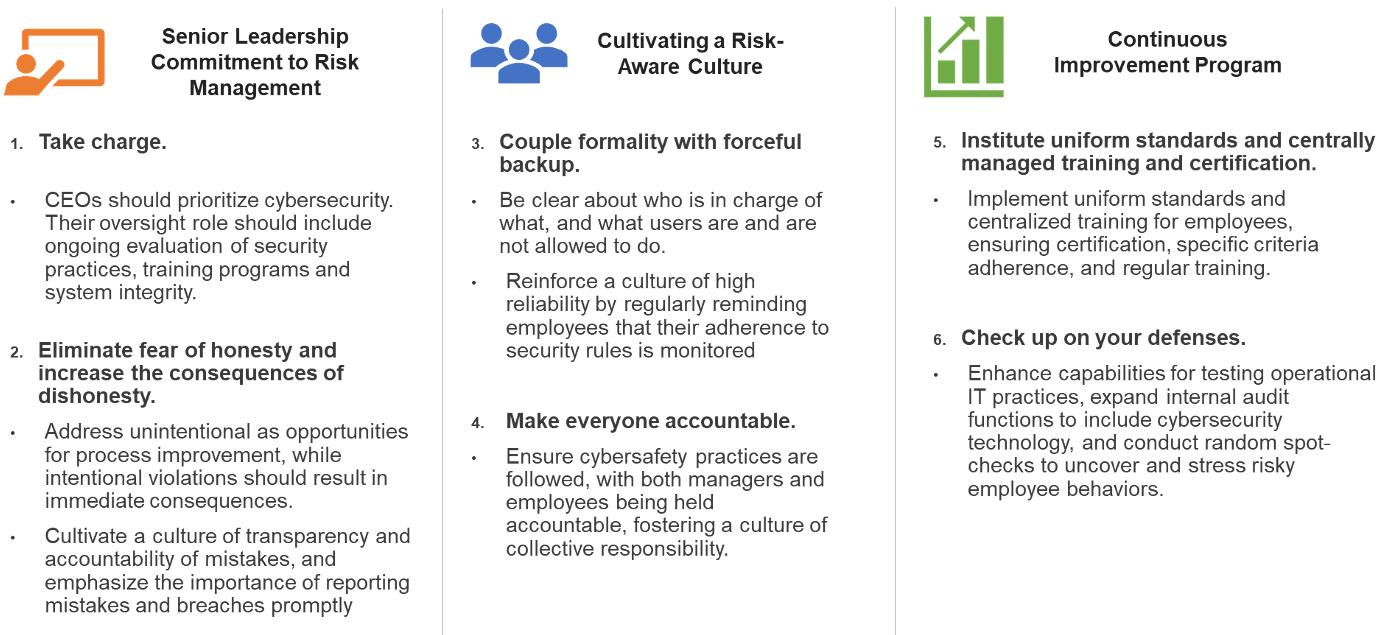
conclusion
In conclusion, High Reliability Organizations (HROs) offer a compelling model for organizations navigating the treacherous waters of unpredictability. HROs maintain constant vigilance, avoid oversimplification, stay attuned to their operational environment, prioritize resilience, and empower expertise. However, the journey towards becoming an HRO is not a one-size-fits-all endeavor. It requires a tailored approach rooted in three fundamental pillars: senior leadership commitment to risk management, cultivation of a risk-aware culture, and the implementation of a continuous improvement program. In our fast-paced world, marked by continuous and rapid change, the path toward becoming a High Reliability Organization is an investment in long-term sustainability and success.
Figure 1: US Army’s Principles for High-Reliability IT organizations
35 Intelligent Risk - February 2024
references
• Schinagl, S., Shahim, A., Khapova, S., & van den Hooff, B. (2023). Digital security governance: What can we learn from high reliability organizations? In T. X. Bui (Ed.), Proceedings of the 56th Annual Hawaii International Conference on System Sciences (HICSS 2023) (pp. 5938-5948). (Proceedings of the Annual Hawaii International Conference on System Sciences; Vol. 2023-January).
• Chassin, M. R., & Loeb, J. M. (2013). High-reliability health care: getting there from here. The Milbank quarterly, 91(3), 459–490. https://doi.org/10.1111/1468-0009.12023
• Bogue, B. (2009). How Principles of High Reliability Organizations Relate to Corrections. Justice System Assessment and Training (J-SAT), Volume 73 Number 3
• Sutcliffe, K.M. & Vogus, T.J. (2003). Organizing for Resilience. In Cameron, K., Dutton, J.E., & Quinn, R.E. (Eds.), Positive Organizational Scholarship. San Francisco: Berrett-Koehler. Chapter 7 pp: 94-110
• Winnefeld Jr., J.A., Kirchhoff, C., and Upton, D.M. (September 2015). Cybersecurity’s Human Factor: Lessons from the Pentagon. Harvard Business Review. https://hbr.org/2015/09/cybersecuritys-human-factor-lessons-from-the-pentagon
• Coutu, D. (April 2003). Sense and Reliability. Harvard Business Review. https://hbr.org/2003/04/sense-and-reliability
• Weick, K. E., & Sutcliffe, K. M. (2001). Managing the unexpected: Assuring high performance in an age of complexity. Jossey-Bass. https://psycnet.apa.org/record/2001-18334-000
peer-reviewed by
Carl Densem
author
Famien Konan

Famien works in the Treasury Clients Solutions Division at the African Development Bank. With over fifteen years of experience in the financial services sector, he also specializes in treasury risk management, and the implementation of quantitative analysis tools and methods for investment management. Mr. Konan began his career as a financial software consultant in the credit derivatives markets. He holds a master’s degree in telecommunications engineering from IMT Atlantique (Telecom Bretagne), as well as a mathematical degree from Université de Bretagne-Occidentale. He is a PRM holder since 2010.
36 Intelligent Risk - February 2024

This article demonstrates how evolving societal expectations and the well-being of future generations determine that ESG is both a key and a challenge to organizations pursuing long-term value creation and financial sustainability.
ESG and world change: the competing perspectives
by Ina Dimitrieva & Elisabeth A. Wilson
preparing for the future
Given their inherent sustainable nature, Environmental, Social, and Governance (ESG) issues appear to be here to stay. Increasing numbers of organizations are recognizing the benefits of leveraging ESG to optimize performance. Capital raised for private market ESG funds tripled between 2020 and 2022, while perceived ESG-related concerns are a growing consideration for whether investors pursue or reject deals1. The link between ESG and long-term value creation is becoming more and more evident.
Still, the stakes for business as usual are rising in the face of evolving regulatory expectations, political opposition, and legal challenges, and it is becoming difficult for organizations to balance pursuit of ESG against positive or negative public sentiment. This is where organizations must identify that there is no winner-take-all scenario in the face of competing perspectives. Regulators are pushing for comprehensive climate change-related disclosures to increase transparency and awareness for investors and other stakeholders. But many corporations are challenging these attempts as overly prescriptive, inconsistent, and premature in the face of ESG data scarcity and complexity of decisionmaking. Non-government organizations (NGOs) are moving the needle in the direction of ESG, but they cannot drive markets without corresponding product availability. On the other hand, consumers, especially younger generations, are interested in environmental and societal advancement— and are willing to funnel their money in this direction 2. This is where organizations are quickly realizing they must not only align with regulatory expectations but need to adapt to consumer preferences, industry competition, and technological advancement in order to radically transform their business models and pursue long-term value creation.
Synopsis
Intelligent Risk - February 2024 37
the rise of ESG
ESG is not a new concept, but it has been slow to gain market traction. However, it came to prominence in 2021 due to myriad factors. The COVID-19 Pandemic and simultaneous, increasingly catastrophic weather events highlighted the mortal, economic, and supply chain repercussions that could result in the face of future extreme climate-related scenarios. Unprecedented social change as a result of the Black Lives Matter Movement in the United States and increased migration of refugees towards Europe in response to war and political instability have shaken perspectives on global and domestic unity. And consumer wariness over governance and ethics remains a key concern since the 2008 Great Recession.
COVID-19 also ushered in an existential crisis for many, prompting The Great Resignation (and the subsequent War on Talent) as people reconsidered their work and family-oriented goals. Increasingly, people want to align themselves with companies that uphold and exhibit their values, which is now one of the motivating factors in the flow of talent.
From a long-term view, ESG will continue to be driven by more environmentally and socially conscious millennials and Generation Z, who stand on the brink of inheriting the wealth accumulated by their baby boomer parents and grandparents. With this Great Wealth Transfer, the next wave of shareholders and investors will come into their prime—and intensify focus on ESG corporate strategy3 .
the regulatory landscape
The European Central Bank (ECB) has identified climate change as one of the major sources of systemic risk in the financial system4. Expectations are moving from voluntary disclosures to mandatory requirements to promote transparency for investors, appropriate market pricing, global alignment, and enhanced risk management around climate change. It is anticipated that these disclosure requirements will positively affect capital markets while encouraging sustainability as an integral part of business strategies in the long term.
While there are numerous climate-focused disclosure frameworks, the “Big Three”5 are:
• Corporate Sustainability Reporting Directive (CSRD): Ushers in the first mandatory regulation to incorporate double-materiality attempts to put sustainability reporting on an equal footing with financial reporting, reduce systemic risk, allocate capital, and increase accountability6. Disclosure requirements will apply to 50,000 organizations within the European Union (EU)—including small and medium-sized enterprises (SMEs)—and impact 10,000 non-EU companies7
• International Sustainability Standards Board Disclosures (ISSB): Introduces a global baseline of sustainability disclosures to satisfy capital market needs. Additionally, ISSB should reduce fragmented disclosure requirements and complexity internationally, expand data access, create better transparency across capital markets to illuminate the true cost of risk, and promote enhanced decision making for long-term value creation 8 .
38 Intelligent Risk - February 2024
• U.S. Securities and Exchange Commission’s Climate-Related Disclosures for Investors: Unveils the most comprehensive guidance for U.S. publicly-traded companies regarding climate disclosures to date. The proposed guidance defines expectations regarding disclosure of Scope 1, 2, and 3 greenhouse gas emissions, actual/potential material climate change-related risk exposures, climate exposure risk governance, utilization of carbon offsets and renewable energy certificates (RECs), and transition plans (and related progress) 9
While these disclosures are heavily predicated on Task Force on Climate-change Related Disclosures (TCFD), which affords a general consistency, they do not allow for comprehensive global alignment or eliminate ambiguity about ESG. How organizations (especially global companies) will navigate these stillevolving regulatory requirements remains to be seen.
legal challenges and legislation
Differing climate change-related litigation strategies have been deployed recently encompassing all perspectives. The biggest group of litigations relate to pro-ESG lawsuits and attempt to influence the debate around decision-making or policy outcomes and to change corporate and societal behavior. New types of cases on the opposite spectrum (anti-ESG) aim to delay or prevent climate action and to maintain the status quo. In the middle is the “Just Transition” litigation strategy, which balances advancing transition to a net-zero carbon economy against protecting the rights of affected stakeholders. Emerging strategic climate-related litigation against companies puts pressure on corporate value chains, or disrupts financing (“turn off the taps”) to projects perceived to be harmful to people or the environment, exposes greenwashing, and promotes investment strategies key to supporting a low-carbon transition10 .
Lawsuits against European governments have been more common to date, such as suing the European Commission (over inclusion of gas and nuclear references in the EU taxonomy11) or Germany (due to accusations the Federal Climate Protection Act violated constitutional human rights12). While climate change litigation tends to be driven by younger generations, seniors are also championing lawsuits such as the Elderly Women vs. Switzerland suit, which argued human rights violations due to insufficient action against climate change and thus initiated a broader fundamental debate on the interpretation of the European Convention on Human Rights13
The first significant constitutional climate trial in the U.S. again saw a group of mainly minors challenge Montana regarding language in the state’s Environmental Policy Act which prevents officials from weighing potential carbon and climate impacts regarding energy ventures14. In what is considered a precedent-setting judgement in the U.S., the final ruling was in favor of the plaintiffs, citing they had a constitutional right to a healthy environment15. It is anticipated Montana will appeal this ruling, adding to the growing efforts of Republican (red)-leaning states to enact anti-ESG legislation, while Democrat (blue)-leaning states are enacting laws to promote focus on climate change. The U.S. is unfortunately famous for its polemic behavior, and a new civil war of sorts is emerging as red and blue pit against each other on the burgeoning ESG battleground.
39 Intelligent Risk - February 2024
value creation
With the world changing in terms of both physical and emotional climate, how an institution approaches ESG is suddenly a demarcating factor in what may draw a much-desired reputational bonus— or less-positive scrutiny. While challenges remain (especially related to climate) regarding regulatory inconsistency, political opposition, legal challenges, and lack of global alignment, ESG offers a common ground for organizations not only to promote global economic stability but to drive company-specific entrepreneurial growth.
Organizations are poised to make a substantial impact on climate change, social equality, and ethical standards while catering to a future wave of investors by growing the baseline beyond mere financial profit-oriented considerations. Though return on ESG may be a long-term gain, there is a proven link between ESG and profitability. Companies prioritizing ESG have seen profits and revenues expand 9.1%, and 9.7% respectively over a three-year span, while 84% of ESG-focused companies recognize their ability to raise capital is less challenging16. Market practices with ESG priorities will contribute to better regulatory and legal alignment globally, in order to be held to a minimum for enabling companies and consumers to thrive in a low-carbon economy. Becoming more sustainable in terms of ESG will also ensure financial sustainability and stability in the long run, as it will support the functioning of the global economy in harmony with nature and people.
By prioritizing ESG, organizations are catering to younger generations, who, thanks to their forebears, in many instances have grown up in wealthy societies with the benefit of disposable income. These younger generations are already showing their proclivity to put their money where their aspirations lie—and they represent the future shareholders, investors, consumers, and talent which organizations need to harness in order to remain competitive and to drive value creation. Entering the new market space with mainstreamed ESG-perspectives is therefore the key for organizations to effectively navigate a changing world—and shape the future.
Disclaimer
All views expressed in this article are our own and do not represent the opinions of any entities that we may be associated with.
40 Intelligent Risk - February 2024
references
1. “ESG defies critics as private markets funds size surge” Adrian Murdoch, Capital Monitor, 28 June 2023, https:// capitalmonitor.ai/asset-class/alternative-assets/esg-defies-critics-as-private-markets-funds-size-surge
2. Wood, John. “Shining A Spotlight On The Great Wealth Transfer – A View From Jersey (wealthbriefing.com).” Wealth Briefing. 5 Dec. 2023, https://www.wealthbriefing.com/html/article.php?id=196382
3. “Failure to Understand Younger Investors Could Affect Advisors’ Ability to Attract Clients, J.D. Power Finds.” J.D. Power, 15 Apr. 2021, https://www.jdpower.com/business/press-releases/2021-us-full-service-investor-satisfaction-study. Accessed 2 August, 2021. Press Release.
4. “Cost-Benefit Analysis of the first set of draft ESRS” – CEPS Final Report November 2022, https://www.ceps.eu/cepspublications/cost-benefit-analysis-of-the-first-set-of-draft-european-sustainability-reporting-standards
5. “Navigating the ESG landscape: Comparison of the “Big Three” Disclosure Proposals”, Heather Horn et al., Harvard Law School on Corporate Governance, 10 October 2022 https://corpgov.law.harvard.edu/2022/10/10/navigating-the-esglandscape-comparison-of-the-big-three-disclosure-proposals
6. “Cost-Benefit Analysis of the first set of draft ESRS” – CEPS Final Report November 2022, https://www.ceps.eu/cepspublications/cost-benefit-analysis-of-the-first-set-of-draft-european-sustainability-reporting-standards
7. “At Least 10,000 Foreign Companies to Be Hit by EU Sustainability Rules”, Dieter Holger, Wall Street Journal, 5 April 2023, https://www.wsj.com/articles/at-least-10-000-foreign-companies-to-be-hit-by-eu-sustainability-rules-307a1406
8. “Effects Analysis” IFRS® Sustainability Disclosure Standards June 2023, https://www.ifrs.org/content/dam/ifrs/project/ general-sustainability-related-disclosures/effects-analysis.pdf
9. “Enhancement and Standardization of Climate-Related Disclosures.” U.S. Securities and Exchange Commission, https:// www.sec.gov/files/33-11042-fact-sheet.pdf?utm_source=eloqua&utm_medium=email&utm_campaign=newsbytes&utm_ content=NEWSBYTES-20220322. Accessed 22 Mar. 2022. Fact Sheet.
10. “Global trends in climate change litigation” Grantham Research Institute on Climate Change and the Environment, June 2023 https://www.lse.ac.uk/granthaminstitute/wp-content/uploads/2023/06/Global_trends_in_climate_change_ litigation_2023_snapshot.pdf
11. “EU faces legal action after including gas and nuclear in ‘green’ investments guide”, The Guardian,18 April 2023, https:// www.theguardian.com/environment/2023/apr/18/eu-faces-legal-action-gas-nuclear-green-investments-guide-europeancommission
12. Neubauer, et al. v. Germany, Global Climate Change Litigation database, http://climatecasechart.com/non-us-case/ neubauer-et-al-v-germany. Accessed 16 August, 2023. Database
13. “Swiss women launch landmark lawsuit in Europe claiming weak climate action breaches their human rights”, Ivana Kottasová, CNN, 29 March 2023, https://edition.cnn.com/2023/03/29/europe/climate-lawsuit-switzerland-european-courtintl/index.html
14. Kluger, Jeffrey. “Kids Just Brought Montana To Court Over Climate Change. The Case Could Make Waves Beyond The State.” Time. 23 June. 2023. https://time.com/6289898/montana-climate-lawsuit-us/
15. Selig, Kate. “Judge rules in favor of Montana youths in landmark climate decision.” The Washington Post. 14 Aug. 2023: https://www.washingtonpost.com/climate-environment/2023/08/14/youths-win-montana-climate-trial/
16. “Link between ESG and profitability exists: New research”, Adrian Murdoch, Capital Monitor, 23 September 2022, https:// capitalmonitor.ai/sector/tech/link-between-esg-investment-exists-new-research/
41 Intelligent Risk - February 2024
peer-reviewed by
Steve Lindo
authors
Ina Dimitrieva

Ina is a business advisor in ESG and Sustainability. She partners with financial institutions, public organizations and management consultancies to accelerate the transition towards a green economy. Ina provides state-of-the-art solutions for financial market participants, enabling them to be forerunners in sustainability and effective managers of ESG risks. She is based in Vienna, Austria.
Elisabeth A. Wilson

Elisabeth Wilson, AVP, Senior Risk Advisory Officer, has worked for over 15 years in the financial industry. Recruited to Atlantic Union Bank’s Enterprise Risk Management Department in 2016, she established and heads the organization’s Environmental, Social, and Governance (ESG) Risk Program. She has contributed to the ABA Banking Journal, The RMA Journal, Risk Management Magazine, and American Banker. Elisabeth is based in Richmond, Virginia.
42 Intelligent Risk - February 2024
The return of inflation has re-ignited risk managers’ concerns over its impact on investment portfolios. Using Canadian investments as an example, the author examines the inflation-hedging qualities of the most common asset classes.
using portfolio diversification to hedge against high inflation
by Andrei Ordine
Diversification is one of the key goals of portfolio managers, and a well-diversified portfolio ideally contains assets suitable for each macroeconomic regime. This article discusses the inflation-hedging abilities of several important asset classes and their current market pricing, and the implications for investment risk managers.

With the fixed income portfolio losses of 2022 in the rear-view mirror, we find ourselves in a better position to invest compared to two years ago because real yields are now positive.
In the wake of the Great Financial Crisis (GFC), central banks maintained overnight rates near 0, resulting in low discount rates and negative real yields. Why was this hard for investors? Treating investment values as discounted cash flows, we see that values were high in part because the discount rates were low. However, in 2022 central banks made efforts to force economic output back to its trend to fight inflation, leading to an increase in real rates and discount rates. As a result, real yields have turned positive, discount rates are higher, therefore expected returns are also higher than they were one or two years ago.
On the other hand, the yield curve has inverted and suggests a possible recession, which might prompt central banks to reduce rates. Should the recession fail to materialize, overnight rates could remain high, and there may be a repricing of the long end of the yield curve, potentially also affecting equities. It is crucial for risk managers to be prepared for such a scenario.
Additionally, the inflation we have experienced, driven by supply factors, may not have completely subsided, while the economy remains resilient and demand appears to be sustaining.
Intelligent Risk - February 2024 43
Synopsis macro overview
In this market environment, which fixed income or alternative investments can provide diversification for a Canadian portfolio? Below we go over the list of typical instruments and discuss their diversification properties in a growth-oriented portfolio.
Domestic Cash: Cash is a riskless store of wealth in nominal terms, but cash deposits have also historically offered at least a partial hedge against inflation. It was only recently, after the GFC, that overnight rates were below inflation (almost 0% in US and 1% in Canada). However, T-bills and floating rate notes are now paying decent coupons with negligible duration risk and may compensate for inflation, even if only partially.
Foreign Cash / FX Exposure: USD and some other foreign currencies are risk diversifiers for Canadian investors. This is because the Canadian dollar is a risk-on currency for US investors due to its reputation as a commodity/materials currency and the smaller size of the Canadian market, and because USD is trading as a global safe harbor. As a corollary, for Canadian investors, USD is also a safe currency, a risk diversifier.
So long as USD assets remain the global safe harbour, having USD exposures reduces the portfolio risk, while hedging out USD exposures actually increases the portfolio risk. For example, if you do a hypothetical experiment and buy S&P 500 and hedge it to CAD, you will have higher risk, larger drawdowns and a somewhat lower return due to the costs of hedging, compared to an unhedged S&P 500 position.
In terms of inflation pass-through, USD cash also has a decent carry now after the Fed rapidly raised interest rates. Historically, USD interest rates have compensated for inflation and may continue to do so in the future.
Longer-Duration Bonds work as portfolio diversifiers in deflationary, bearish market episodes such as during early COVID in 2020 and will continue to do so, if the USD remains the safe haven for investments. US government bonds are also a source of liquidity when needed.
Current bond yields are still lower than the cash rates (10 and 30-year yields close to 4.0% versus short rates above 5.3%), so caution should be taken with longer-duration bonds. If overnight rates remain at their current levels for longer, then longer-duration bonds may experience another repricing.
In terms of inflation, longer-duration bonds were never an inflation hedge, as long-term nominal government obligations experience a permanent loss in real terms during periods of high inflation.
Inflation-Linked Bonds (ILB) is one asset class which offers mathematical protection against CPI: by construction their principal and coupon payments are linked to inflation and in that sense, they offer a perfect hedge against inflation.
Unfortunately for investors entering the market around 2011, the real yields offered by ILB were negative in short maturities and only slightly positive in longer ones, so the realized returns since then have been low. Investors should rejoice that real yields in USD are now positive across the whole range of maturities at around 2%.
44 Intelligent Risk - February 2024
Also, note that Canadian ILB (Real Return Bond) issuance has stopped for now, while US inflation-linked bond issuance continues. Canadian investors may have to use secondary Canadian markets or the US markets to get their inflation-linked exposure.
Levered Loans are secured high-yield floating rate debt instruments. They are a package of short-rate exposure and credit risk, and typically they are secured. The coupons are calculated as a benchmark short rate + spread so there is very little duration risk.
High-yield debt has recovered from the slump of 2022: current credit spreads of approximately 330bps in US speculative grade debt are lower than the historical average of 540bps and close to low levels (300bps) of the recent decade1
Utilities Equity: Utilities typically are regulated monopolies which provide essential services such as energy, water or gas delivery services to individuals and businesses, with a state or province-level regulator authorizing the fees charged to their consumers. In US, under the “rate case” mechanism, utilities request the approval of the desired return on their regulatory asset base, a measure of capital invested, every few years. This potentially allows them to incorporate higher inflation into the return calculation. In many countries, Australia for example, the regulatory asset base is indexed to inflation explicitly2. Many regulators use the weighted average cost of capital approach for determining utility rates, where the “risk-free” rate forms the basis of the required return3. As we discussed above, these risk-free rates have historically protected investors against inflation.
Granted, utilities are complex businesses that face operational4, weather5 and other risks; investors are allowed to earn premium for those risks. They also face regulatory risk, since regulators sometimes use complex financial and econometric models, such as the Capital Asset Pricing Model, to determine the allowed rate of return. However, if the governance, management and operations of a utility are solid and the regulatory regime is supportive for investors, then utilities’ cash flows can offer good inflation protection.
Toll Roads and Other Infrastructure: Infrastructure is a very broad label; each asset has its own properties, and in some cases the operator can increase the fees with inflation every year. For example, some roads of the Transurban toll road system in Australia have their tariff linked to inflation6 (with a lag for data release). When the traffic is steady and does not depend strongly on pricing and economic conditions, toll road with inflation linked tariffs will provide inflation-protected cash flows. Some toll roads are essential routes, but some are “overflow” roads which lose more traffic when the economy contracts.
Other types of infrastructure equity, for example listed midstream energy assets (MLPi) that store and transport oil and gas and their products, also operate in a “toll road” fashion, collecting fee income. However, their capital structure and MLP tax-exempt status, plus a particular retail and HNWii investor base7, created returns that are much more volatile than suggested by their core business. Empirically, MLPs’ total return has been correlated to energy prices8. Therefore, the inflation protection properties of MLP may be overshadowed by other factors.
i / Master Limited Partnership, a pass-through structure that is not taxed at the corporate level. ii / High Net Worth 45 Intelligent Risk - February 2024
To conclude, the inflation protection capacity of infrastructure investments should be determined on a caseby-case basis, because the asset class is very broad and non-homogeneous.
Real Estate: Real estate has some inflation-hedging properties, but it depends on the type of asset. Cost of shelter has a 34% relative importance in the Consumer Price Inflation basket in the US.9, suggesting that residential real estate should have some inflation-hedging properties, especially in high-demand areas.
However, the cash flows in other types of properties are driven by economic growth, interest rates, and other premia, and inflation may not be their main driver10. Anecdotally, during the period of inflation targeting by central banks, many leases did not contain inflation escalation clauses, so institutional-grade properties with AAA tenants and long leases have turned into nominal bonds, at least in the medium term.
Recent years have seen industrial property valuations skyrocket, residential asset values keep up, while offices and some retail asset values have slumped. We can also compare pricing in the REIT market with appraisal-based direct property valuations. Currently REITs are priced quite cheap relatively to appraisals11 . The median premium/discount was 20% in US REITs at the end of November 2023, and office REITs were traded at 37% discount to their NAV. Industrial REITs had a discount of 14%, data center REITS traded at a premium of 15%, and hotels’ discount to NAV were not that far from office at 28%. Therefore, for many types of properties, REITs can be used currently to obtain real estate exposures cheaper than direct investments or fund investments.
summary
We have discussed several common income-type asset classes and discussed their ability to protect investors from inflation. We also reviewed the current pricing of these asset classes (where possible). The following table summarizes the conclusions by asset class of the inflation-hedging properties of these asset classes.

*The protection is not perfect but has held up historically and is in place currently (i.e., short rates are above inflation)
**Levered loans exposure includes credit risk
Intelligent Risk -
2024
46
February
conclusions for risk managers
Risk managers need to be prepared for different future inflation scenarios, including those where inflation re-emerges at higher levels than observed before, and those of deflation. Risk managers can evaluate the impact of unexpected inflation and interest rate curve changes by explicitly incorporating it in the valuation of portfolio investments and using scenario analysis tools to shock current inflation projections.
This is relatively straightforward for government and corporate debt. Moreover, viewing investment values as discounted cash flows allows this approach to be expanded to other investments, such as real estate and infrastructure. Most unlisted investments’ underwriting assumptions already include projections of future cash flows and discount factors under different scenarios, and these assumptions can be re-used for portfolio and risk management purposes.
With discounted cash flow and scenario analysis tools under their belt, risk managers can effectively generate inflation scenarios for entire portfolios and prepare for unexpected inflation outcomes.
references
1. Source: FRED, ICE BofA US High Yield Index Option-Adjusted Spread
2. Australian Energy Regulator Factsheet: Why do we index the regulatory asset base?
3. WACC and CAPM according to Utilities Regulators: Confusions, Errors and Inconsistencies, Pablo Fernandez, IESE, 2019
4. PG&E’s electric transmission lines are believed to have caused wildfires in California: https://www.pbs.org/newshour/ nation/pge-to-pay-55-million-for-two-massive-california-wildfires.
5. Utilities face greatest threat as climate risks intensify, S&P, Sep 2021
6. Taking-shelter-from-inflation, Maple-Brown Abbott, July 2021
7. The 2015 MLP Crash; Why and What’s Next – SL Advisors, 2015
8. https://fulfillment.rbadvisors.com/images/pdfs/Special_Note_Are_MLP_returns_correlated_to_Oil_Prices_I.pdf
9. https://www.bls.gov/cpi/tables/relative-importance/2022.htm
10. “Real” Assets, Andrew Ang, Sep 2012
11. NAV Monitor: NAV Monitor: US REIT discount to net asset value narrows in November, S&P, December 2023
47 Intelligent Risk - February 2024
Steve Lindo
Andrei Ordine

Andrei is an investment professional with over 15 years of industry experience. Andrei’s work is focused on macro investing and systematic investment strategies.
Andrei most recently served as a Senior Associate at CPP Investments, where he led a number of total fund management initiatives, performed strategic allocation across factors and investment programs, and constructed quantitative investment strategies. Prior to joining CPP Investments, Andrei provided risk model validation consulting services to the Ontario Teachers’ Pension Plan and was a part of a risk management group at the Bank of Nova Scotia, where he supported the prime brokerage business.
Andrei holds a PhD in Mathematics from Queen’s University and a Masters’ in Applied Mathematics from Moscow State University.
author
48 Intelligent Risk - February 2024
peer-reviewed by
Synopsis
Psychology, sociology, storytelling, systems thinking, business acumen, continuous learning: these are skills which are vital to successful risk managers, but are rarely if ever taught in graduate risk programs.
what they don’t teach you at risk school
by Rick Nason
Back in 1984, Mark McCormack wrote a best-selling book titled “What They Don’t Teach You At Harvard Business School” (McCormack, 1984). Mr. McCormack was the sports agent who created the profession of sports agency and made professional sports what they are today. His book was a description and explanation of all of the critical skills necessary for success in business that one did not obtain in business school. The book was a huge success and caused many business schools to reconsider much of what they taught and how they taught it. I read the book while in business school in the late 1980s and it has remained an influence in my personal and professional life since.
In my experience in working with several different M.Sc. programs in risk management, and in my consulting and training career, I see a need for a similar book for risk management. If I was to write such a book, these would be the six key chapters.

The perception in most risk programs is that risk is all about the mathematics of risk and modelling. Quantitative skills are obviously important for a career in risk management, but they will only get you an entry level position. Risk management is so much more than simply quantitative analysis. This is going to be even more so going forward as Artificial Intelligence is already taking over many of the quantitative tasks, and even some of the qualitative ones.
Inanimate objects are rarely totally unpredictable: but people are. Thus, risk management is ultimately about people. Despite this fact, psychology and sociology are rarely discussed in risk management programs, with the sole exception perhaps of some behavioural finance. Psychology is about how people as individuals act irrationally, or inconsistently, or just plain stupidly. Sociology is about how people in the context of groups act irrationally, or inconsistently, or just plain stupidly. Both aspects of human behavior are key to effective risk management. Understanding why people do the things they do, and strategies to help them develop better actions is key to becoming a risk management leader.
1. Quantitative skills are simply table stakes for a career in risk management.
Intelligent Risk - February 2024 49
2. Psychology and sociology.
Risk management is about understanding stories about how the future may evolve. World-class risk managers are excellent at creating stories, and the more creative the better. Risk management is about managing the unexpected, and it is a critical skill to understand how stories may unfold in order to determine the most effective possible responses. While forecasting is a key component of almost all risk management programs, the reality is that forecasting is not storytelling. Forecasting is generally (at its worst) a form of econometric modelling from the past.
While it may be true that “history does not repeat itself, but it rhymes”, the reality is that the most significant risks are almost unique and unforeseen, and perhaps even unforeseeable. Creating stories (as promoted by Peter Schwartz in his classic book, “The Art of the Long View” (Schwartz, 1996) gives one better insight into the many variables – both quantitative as well as qualitative – that may come into play. Furthermore, it is not just enough to be able to create the stories, but risk managers must also be able to tell the stories about the possible future. This sales aspect of risk management is often underappreciated. The best risk plan that does not get effectively communicated and sold to other management teams will almost assuredly be ineffective. Effective risk management is integrated risk management. That was the premise behind the term “Enterprise Risk Management”. Few risks can be understood or managed without regard to the broader context and associated connections. Yet most risks are managed in silos, and thus the proliferation of different risk specialties. An understanding and appreciation of the basics of systems thinking and its offshoot complexity science is necessary to overcome this shortcoming. Complexity science is admittedly still in its infancy, but then again so is risk management as an organizational practice when compared to other professional fields such as accounting or marketing. Complexity skills are the complement to the complicated (quantitative) thinking skills that are the dominant part of almost every risk management program. Complexity science is also going to become increasingly important as A.I. takes over more of the complicated systems of risk management. Every risk manager should have basic business acumen gained through some form of business experience and profit and loss responsibility. Sadly, this is rarely the case, and rarely is general business acumen developed in risk programs. The process of creating and developing an idea, producing a product or service, creating customers, and managing so as to make a profit is the ultimate risk management exercise.
The perception is that, with an M.Sc. in Risk degree in hand, one is ready to be a risk manager. Not even the best of programs - even if they incorporate all of the above ideas – will ever prepare one for a full career as a risk manager. The reality is that risk management as a profession is one that requires continual learning. While the basics may stay the same, the story of risk is constantly evolving. Ultimately a risk manager’s education begins the day that he/she leaves university.
3. Story creation (and telling) skills.
4. Systems thinking and complexity science.
5. General business and organizational acumen.
6. Risk management education never ends.
50 Intelligent Risk - February 2024
references
McCormack, M. H. (1984). What they don’t teach you at Harvard Business School. Toronto; New York, Bantam.
Schwartz, P. (1996). The Art of the Long View: Planning for the Future in an Uncertain World. Currency.
peer-reviewed by
Steve Lindo
author
Rick Nason, PhD, CFA

Rick Nason, PhD, CFA, is an Associate Professor of Finance at Dalhousie University where he been awarded numerous awards for teaching excellence. His academic work includes researching corporate risk management and complexity in business. As a former capital markets, as well as corporate learning professional, he remains active in consulting and corporate training, specializing on applications of complexity science and risk management.
He is the author / co-author of seven books and textbooks, including It’s Not Complicated: The Art and Science of Complexity in Business, published by University of Toronto Press, and Rethinking Risk Management, by Business Experts Press.
51 Intelligent Risk - February 2024
Power grids are foundational to much of today’s interconnected world. In a country like South Africa, which has experienced intermittent power for several years, the dangers for an economy and society are laid bare. This article looks at ways to build grid resilience and adds the emergence of data-driven inspections to the arsenal of tomorrow’s risk managers.
the risk mitigation power of data for our most foundational infrastructure: the power grid
by John Smithers

In today’s interconnected world, the power grid has become the backbone of modern society. It is the lifeline that ensures the uninterrupted distribution of electricity to homes, businesses, hospitals, and countless other critical institutions. However, the risks associated with a failing power grid are increasingly evident, as demonstrated by the situation in South Africa where interruptions to the power grid are a daily occurrence with economic impacts. This highlights the urgent need to protect this foundational infrastructure, given the enormous ramifications it can have on the functioning of society as a whole.
causes of failure: the case of South Africa
A power grid failure can occur due to various reasons, including natural disasters, equipment malfunctions, cyberattacks, and human error. Regardless of the cause, the consequences can be devastating. When the power grid goes down, the ripple effects can be felt across multiple sectors, leading to widespread disruption and chaos.
South Africa serves as a poignant example of the risks involved. In recent years, the country has experienced frequent power outages, leading to a phenomenon known as “load shedding.” Load shedding occurs when the electricity demand surpasses the available supply, forcing utilities to implement planned rolling blackouts. These outages have had a severe impact on businesses, resulting in lost productivity, financial losses, and a decline in investor confidence.
Intelligent Risk - February 2024 52
Synopsis
introduction
Moreover, load shedding also affects essential services such as hospitals, where power is crucial for lifesaving equipment and the refrigeration of vital medicines. The inability to maintain a reliable power supply puts lives at risk and poses a grave challenge to the healthcare system’s functionality.
widespread impacts
Beyond the immediate impact on businesses and essential services, a failing power grid has far-reaching consequences for society as a whole. With the increasing dependence on technology and digital systems, an extended power outage can disrupt communication networks, financial transactions, and transportation systems. Imagine the chaos that would ensue if traffic lights stop working, air traffic control systems fail, or communication channels become inaccessible? The repercussions would be profound, leading to widespread confusion, economic losses, and potential safety hazards.
The risks associated with a failing power grid go beyond domestic concerns. Modern societies are highly interconnected, and disruptions in one region can have a cascading effect on others. In the case of South Africa, the unstable power grid has not only affected its economy but has also had implications for neighboring countries that rely on its power exports to run their own grids. This demonstrates the importance of a secure and resilient power grid, not just for individual nations but also for global stability.
preventing power grid failure
Addressing the risks to the power grid requires a multi-faceted approach. Firstly, investment in infrastructure upgrades and maintenance is essential. Many power grids around the world are ageing and vulnerable to failure. Upgrading equipment, improving transmission and distribution systems, and implementing modern technologies can enhance reliability and resilience.
Secondly, cybersecurity measures must be a top priority. With the growing threat of cyberattacks, power grid operators need to invest in robust security systems to safeguard against potential breaches. This includes regular vulnerability assessments, employee training on cybersecurity best practices, and partnerships with cybersecurity experts to stay ahead of evolving threats.
Thirdly, diversification of energy sources is crucial. Overreliance on a single source of energy increases vulnerability. Investing in renewable energy, such as solar and wind power, can provide a more decentralized and resilient energy system. Distributed generation and microgrids also offer potential solutions by allowing communities to generate and store their own energy, reducing dependence on the central power grid.
53 Intelligent Risk - February 2024
data’s role in grid resilience
Furthermore, advancements in technology can play a significant role in mitigating risks to the power grid. Through AI-powered, but human-made, analysis of the power grid, owners and operators can obtain comprehensive data needed to identify and address potential issues.
Previous work with power grids in the US and within Europe consistently revealed ten times the number of defects compared to prevalent inspection methods. Projects run with E.ON’s Swedish branch, one of Europe’s largest power grid owners, regularly found ten times the critical defects and far more noncritical issues. Better insights allow for proactive maintenance and repairs, minimizing the risk of failures and ensuring the grid’s reliability. The risk and loss mitigation power of data on the real physical assets’ health is going to be the strength of risk managers in the coming years, allowing them to drive significant improvements in their processes.
With enhanced data capabilities, power grid owners can adopt a significantly more proactive approach to grid management. Conducting comprehensive risk assessments on power lines, supplemented by data concerning affected end-customers and other weather-related vulnerabilities, enables power grid owners to substantially reduce outages stemming from identified defects. Rather than addressing each defect as it arises, they can gain a comprehensive overview and issue work orders to their linemen for the simultaneous repair of all current defects and issues along a stretch of power lines. This strategic approach helps preempt both planned and unplanned outages that might otherwise occur, contributing to a more resilient grid.
Moreover, data-driven decision-making not only enhances routine maintenance activities but also revolutionizes investment planning for power grid owners. Shifting from traditional modeled component lifetime management to a dynamic asset health analysis allows them to potentially extend the grid’s operational life well beyond predicted timelines. Treating each component as an individual entity with up-todate information derived from real-world conditions ensures that resources are allocated more efficiently. Repairing components proves to be significantly more cost-effective than replacing them, and by prioritizing maintenance efforts, investments can be directed to areas where they can exert the greatest positive impact.
In addition, risk mitigation strategies can be integrated into the planning process, such as proactive component replacements in high-risk areas or diversification of energy sources to reduce vulnerability to weather-related disruptions. This holistic approach not only improves the grid’s longevity but also enhances its overall resilience and adaptability.
54 Intelligent Risk - February 2024
conclusion
Ready access and availability of data on the physical infrastructure can be the make or break of the power grids. With mounting pressures from demand and supply, alongside deteriorating components, the time to act is now. This is where AI and data management solutions can truly digitalize the workflow and management of power grids. Providing highly contextualized data that can empower investment and maintenance decisions that, both short- and long-term, can mitigate risks on an unforeseen scale. However, the road to this requires joint efforts from lawmakers, grid owners, and service providers. It’s a joint effort managing risks, but the opportunity is greater than ever before.
peer-reviewed by
Carl Densem
author
John Smithers

John has a diverse background including 16 years in Enterprise Technology and 6 years in Wholesale Lending. He is well versed in commercial operations, enterprise risk management and working with global teams. John’s previous stints include time at Oracle, Cogent Communications and several exit stage startups.
55 Intelligent Risk - February 2024

Synopsis
The way regulators treat securities financing transactions, or SFTs, is changing under Basel’s capital guidelines and currently being phased in by regulators. With the popularity of SFTs in raising shortterm financing and the implications for banks on capital requirements, risk managers at banks need to clearly understand these new rules. Further, to maintain compliance and optimize these capital calculations, banks should proceed with a solution that satisfies its needs.
Basel III compliance with securities financing transactions
by Edward Bace
introduction
The purpose of this paper is to discuss compliant and optimised Basel 3 capital calculations for a bank, specifically focused on Securities Financing Transactions (SFTs). SFTs involve borrowing or lending securities in order to raise short-term financing, and they can make up a significant portion of a bank’s risk-weighted assets (RWAs). As such, it is important that the calculators used to determine RWAs for SFTs are both compliant with the new Basel 3 regulations and accurately reflect the risk to which the bank is subjected (International Capital Markets Association, 2022).
In order to meet these requirements, the bank must update its existing calculators to ensure compliance with the new regulations and avoid overly punitive RWAs. This involves a thorough understanding of the new regulations and the specific requirements for different types of risk-weighted asset and leverage ratio calculations. It also involves working with technology to deliver these calculations, and testing them with business users to ensure that they are fit for purpose and accurately reflect the risk to which the bank is subject (Bank for International Settlements, 2022).
Basel 3 background
Basel 3 is a set of international banking regulations that were introduced in response to the global financial crisis of 2008 (Bank for International Settlements, 2017). These regulations, which are then enacted by national authorities, aim to improve the resilience of the banking sector and reduce the risk of financial instability. The finalised version of Basel 3, which was released in 2017, introduced new requirements for risk-weighted asset and leverage ratio calculations, including those related to Securities Financing Transactions (SFTs).
Intelligent Risk - February 2024 56
Compliance is mandatory for a bank, and of key significance as it directly affects the Tier 1 capital the bank must hold to ensure its ability to weather most stress scenarios (Bank for International Settlements, 2018).
SFT changes
The revisions to the Basel risk framework are mainly to strengthen its risk sensitivity, increase robustness, and improve consistency. All SFTs (not just those deemed material by supervisors) are to be included in the framework. For example, transactions or Netting Agreements that do not meet the Minimum Haircut requirements are treated like ‘unsecured loans.’ They receive a 100% haircut which means collateral is completely ignored in the EAD (exposure at default) calculation. This has a significant impact in terms of increasing EAD, and therefore, RWA and capital requirements. This change is critical since the SFT portfolio is also affected by the output floor, which is set at 72.5% of the RWA using the Standardized Approach. Besides certain exemptions, everything is classified as ‘in-scope’ for minimum haircut floors and has to go through a specific calculation based on whether it has a valid netting agreement or not. See Box 1
Box 1 – Example of SFT Changes on RWA and Capital:
A bank posts $102 of cash with an unregulated counterparty in exchange for $100 of equity securities. Since the bank posted more collateral than it received, it fails the minimum haircut floor criteria. A 100% haircut is applied and the transaction is treated like an unsecured loan (i.e. zero collateral is used to reduce EAD). Exposure is the full $102.
In previous capital treatments, the exposure was equal to posted collateral (cash) less collateral (equity securities) reduced by a haircut: $102 – ($100 - $10 haircut) = $12.
However, under the new minimum haircut rule, since the bank posts more than it receives ($102 vs. $100), it fails the haircut floor requirement, and thus the entire cash amount has to be treated as unsecured, effectively ignoring the cash collateral received.
The result is a 750% ($102/$12) increase in exposure and associated capital requirement (ISDA, 2021).
SFTs can be somewhat complex, and can sometimes be preponderant in a bank’s activities, accounting for a meaningful proportion of RWA (International Capital Markets Association, 2021; European Commission, 2017). It is thus of paramount importance that calculators to determine RWAs for SFTs both comply with the new Basel 3 regulations and capture accurately the risks to the bank, as well as being well optimised to ensure a fair outcome for the bank without being too punitive due to relying on fallback calculations (International Swaps and Derivatives Association, 2022).
In order to achieve this, the bank must update its existing calculators to ensure compliance with the new regulations and avoid overly punitive RWAs.
57 Intelligent Risk - February 2024
process of enhancing SFT calculators
Creating compliant and optimised Basel 3 capital calculations, specifically focused on SFTs, involves a thorough understanding of the regulations and the specific requirements for different types of risk-weighted asset and leverage ratio calculations, as well as working with technology to deliver these calculations and testing them with business users. This will allow identification of any areas where the updated calculators may be overly punitive or do not accurately reflect the risk that the bank is subject to, and highlights the necessary adjustments to be made. Thereafter the updated calculators can be presented to relevant stakeholders for review and approval.
Primary sources to inform this process include:
• Basel text (BCBS guidelines)
• Rules issued by the regulator
• Q&A documentation issued by the regulator
• Interactions with the bank’s regulatory accounting policy team
• Interactions with regulatory bodies
The results of this exercise should emerge as follows:
• Compliant and optimised calculators for determining RWAs for SFTs that meet the new Basel 3 regulations and accurately reflect the risk that the bank is subject to
• Improved compliance with the new Basel 3 regulations and a more accurate representation of risk in SFTs
• Increased confidence from stakeholders in the accuracy and reliability of the calculators
Success of the exercise can be measured by 100% compliance with the Basel 3 finalisation standards for the capital calculators used to generate Risk-Weighted Assets for the securities financing transactions portfolio.
Supporting evidence for this exercise should include:
• High level documentation identifying key changes in regulation
• Detailed business requirements to support calculator build
• Testing outcomes of the calculator
• Communication from key stakeholders that the calculator is generating rational outcomes
• Following best practice, confirmation from key stakeholders that the calculator meets compliance standards (Choudhry, 2022)
58 Intelligent Risk - February 2024
references
In the U.S., banks have been required to make these adjustments for reporting purposes by January 2022, however there is a phased in approach for capital purposes with output floors starting at 50% in 2022 and stabilising at 72.5% in 2027 (SIFMA, 2023). Banks have time to make sure their calculators for SFTs are well-calibrated but need to ensure compliance as soon as possible.
references
• Bank for International Settlements. (2017). Finalising Basell III. https://www.bis.org/bcbs/publ/d424_inbrief.pdf
• Bank for International Settlements. (2018). Stress testing principles. https://www.bis.org/bcbs/publ/d450.pdf
• Bank for International Settlements. (2022). Instructions for Basel III monitoring. https://www.bis.org/bcbs/qis/biiiimplmoninstr_sep22.pdf
• Choudhry, M. (2022). Principles of Banking (2nd ed.). Wiley Finance
• European Commission. (2017). Securities financing transactions (SFTs). https://finance.ec.europa.eu/capital-markets-unionand-financial-markets/financial-markets/post-trade-services/securities-financing-transactions-sfts_en
• European Banking Authority. (2019). Policy advice on the Basel III reforms on Securities Financed Transactions (STFs). https://www.eba.europa.eu/sites/default/documents/files/documents/10180/2886865/870bbd5e-ae8f-4933-9f36784c7183c7f4/Policy%20Advice%20on%20Basel%20III%20reforms%20-%20SFTs.pdf?retry=1
• International Capital Markets Association. (2021). SFT RWA considerations. https://www.icmagroup.org/assets/documents/Events/SFT-RWA-ICMA-002.pdf
• International Capital Markets Association. (2022). Prudential Treatment of SFT counterparty risk under Standardised approach. https://www.icmagroup.org/assets/documents/Regulatory/Repo/ICMA-ERCC-Position-Paper_PrudentialTreatment-of-SFT-counterparty-risk-under-standardised-approach_July-2022-050822.pdf
• International Swaps and Derivatives Association. (2022). CRR 3 - Counterparty Credit Risk. https://www.isda.org/a/z2PgE/AFME-ISDA-CRR-III-CCR-Position-Paper.docx
• International Swaps and Derivatives Association. (2021). BCBS consultation – Minimum haircut floors for securities financing transactions: Technical Amendment. https://www.isda.org/a/WEFTE/BCBS-consultation-%E2%80%93-Minimum-haircutfloors-for-securities-financing-transactions.pdf
• SIFMA. (2023). The Federal Reserve Should Remove “Gold-Plating” in the Basel 3 Endgame. https://www.sifma.org/resources/news/the-federal-reserve-should-remove-gold-plating-in-the-basel-3-endgame/
59 Intelligent Risk - February 2024
authors
Edward Bace

Edward Bace is a lecturer and trainer, with over 30 years’ experience in financial, economic, and risk analysis, gained from careers in banking and university activity in the US and Europe. He has published numerous articles and presented at conferences on these subjects.
Edward has a Postgrad Certificate in Higher Education and is a Senior Fellow of Higher Education Academy. He has an MBA from NYU, and a PhD from University of Michigan. He possesses a Bachelor’s in Chemistry, is a CFA, Chartered MCSI, and Member of PRMIA, where he has represented their Global Ethics & Professional Standards Committee.
peer-reviewed by
Carl Densem
60 Intelligent Risk - February 2024

There is ample evidence that birth rates affect climate change. However, as in other complex adaptive systems, cause and effect are far from predictable. This article examines risks which have emerged from existing, well-intentioned government birth control interventions and advocates caution in such initiatives until a better understanding is achieved of how these phenomena interact.
why a low birth rate may be the biggest risk of all
by Carl Densem
the impact of birth rates on climate change
In Sir David Attenborough’s new Netflix documentary, A Life on Our Planet, one of his suggested solutions to the problem of climate change is population control. His example for this ideal is Japan, which has seen its population decline 6 million since peaking at 128 million in 2010 (The World Bank, 2022). If only, to paraphrase Sir David, living standards could be raised like Japan in less prosperous countries, then there would be more smaller families and lower demands on the Earth’s limited resources.
However, Japan has not been so quick to celebrate this turn of events, for reasons that we will return to later on. Right now, let us address the question ‘what does this have to do with risk?’
On a daily basis: almost nothing. In the long run though, shrinking populations caused by low birth rates alter societies, economies, and cooperation between states. Low birth rates can be difficult to escape too, as will be demonstrated, and cause ills that are arguably worse than the consequences of high birth rates. Finally, what makes low birth rates potentially the biggest risk of all is that their decline may be irreversible; in attempting to save the planet, societies may inadvertently cause their own extinction.
The argument offered by Sir David, that lowering population growth can help meet climate goals like the Paris agreement, is sensible, especially for parts of the world where high population growth requires the use of coal and other “dirty” energy sources. The current mix of energy sources is not sustainable when world population is projected to increase (until finally leveling off at about 10 billion) and, simply put, fossil-fuels are a finite resource (UN, 2022). Further, sitting by as the world heats beyond the thresholds laid out by climate scientists is considered a catastrophic risk to humanity.
Risk managers are well-equipped to evaluate first, the coming scale of population loss, and second, the risks that this may cause. Armed with a thorough understanding of these phenomena, they can better see where the puck is going (for non-Canadians: what the future holds) and better fathom the unforeseen impacts.
Synopsis
Intelligent Risk - February 2024 61
two questions that need to be asked
None of the above is controversial and we need not spend time on it. Where the prevailing wisdom appears to be poorly considered is the blanket assumption that all falling birth rates (even those already below replacement) are good. Two questions need to be asked:
1. Can population change truly be controlled?
The post-WWII baby boomer generation was not the deliberate result of incentives to have more children. After more than 70 years, the reasons for this temporary reversal in the declining birth rate escapes clear explanation. How do we know? Because repeating it has proven elusive outside of minor, short-run studies. Quebec, for example, was only able to raise its fertility rate with an array of financial help to parents for all of 2 years in the 1980s (PRB, 2001).
To give some flavour of other attempts at trying to boost birth rates:
• Hungary exempts mothers from income tax if they have more than three children.
• South Korea awards cash to expecting parents and then pays them progressively more for each child the family has; they also subsidize fertility treatment and offer free parking, free day care and housing assistance
• Berlin, in Germany, has totally done away with fees for municipal day care centers
The polar opposite exists too: despite China’s one-child policy becoming a two- and then three-child policy, Chinese women are having fewer and fewer children (figure 1). Their population could be just one-third its current size by 2100. To imagine that societies can control population growth is fanciful if even the strongest state intervention cannot move the needle.
Were it possible to guide birth rates such that climate change achieves balance, steps should be immediately taken. The evidence we have, however, puts such capabilities beyond our grasp.
 Figure 1: China’s feritlity rate (Pew Research Center)
Figure 1: China’s feritlity rate (Pew Research Center)
2. What does a declining population look like?
Smaller populations do demand fewer resources. What is not expressed, or perhaps not as well understood, is that populations do not decline uniformly across age groups. With people living longer thanks to better healthcare, what happens in reality is that a bulge forms at the upper part of the population pyramid. Instead of a “chimney” shape in which younger generations gradually replace older ones, the pyramid inverts with a smaller working age population and even less in diapers. Japan is a vivid example of this “spinning top” shape:

This has foreseeable outcomes for the country:
Economic
The generational imbalance throws the modern economic system into disarray: jobs are left unfilled, houses stand empty and resources are safeguarded rather than invested. Capital, the lifeblood of developed countries, moves from riskier stock markets to safer bonds and other savings products to conserve principal. Without available capital, start-ups and technological advancement stall. These effects are quite clear in Japan.
Social
Young people are attracted to opportunity, which will be sparse in a slowing economy unwilling to gamble on new ventures.
63 Intelligent Risk - February 2024
Figure 2: Population pyramid for Japan in 2023 (U.S. Census Bureau)
Without the creation of families, the point of which is generally to have children, people tend to be lonelier and lack the supports of larger families. The UK announced a loneliness strategy in 2018 to curb these harms (UK Government, 2018). Suicide and violence increase in societies beset with hopelessness, something we may currently be dealing with in developed countries. Again, Japan struggles with young people moving away, lack of family creation and suicide.
Political
Politicians turn to the needs of an aging population which are vastly different from a majority which needs to get to work (roads, bridges, tunnels), connect (digital networks, satellites), and grow wealth (land development, asset markets). While priority is placed on the state pension, nursing homes and healthcare, military strength is allowed to atrophy. This makes it hard to maintain alliances and keep faster-growing (or faster-shrinking) enemies at bay.
is Japan celebrating?
In theory, Japan should be the blueprint for solving climate risks. Japanese enjoy a high standard of living, their birth rate is low and they are keen to produce clean energy. And yet no celebrations are planned. Rather, the Japanese government is doing everything it can to reverse the now-deeply embedded trend in childlessness. In 2023, the Children’s Policies minister (the position itself speaks volumes) said the latest measures to boost birth rates is a “last chance,” as the rate at which the young population is shrinking will double in the 2030s (Yamaguchi, 2023).
conclusion
Risk managers should always be careful of one-size-fits-all solutions and notice unintended consequences. The poor evidence for lowering birth rates to solve climate risks appears to be one such incomplete fix. As the push for globalized climate solutions, such as COP28, come into action, we should be aware that fast-aging populations’ priorities might shift, that threatened nations might not worry as much about carbon credits. While risk managers can feel strongly about finding a solution to sustaining our environment, we should also understand what can go wrong. Sir David Attenborough’s intentions are not in question, but his plan of action lacks the rigor of a good risk manager.
64 Intelligent Risk - February 2024
references
• The World Bank, Data. (2022). Population, total – Japan. https://data.worldbank.org/indicator/SP.POP.TOTL?locations=JP
• PRB. (2001, December 1) Quebec’s Alternative to Pronatalism. Population Reference Bureau. https://www.prb.org/ resources/quebecs-alternative-to-pronatalism/#:~:text=In%20a%20population%20engineering%20effort,subsequent%20 birth%20(one%20Canadian%20dollar
• UK Government. (2018, October 16). PM launches Government’s first loneliness strategy [Press release]. https://www.gov. uk/government/news/pm-launches-governments-first-loneliness-strategy
• United Nations. (2022). Global Issues: Population. https://www.un.org/en/global-issues/population#:~:text=The%20world%20 population%20is%20projected,and%2010.4%20billion%20by%202100
• Yamaguchi, M. (2023, March 31). Japan unveils proposal to promote marriage, raise birthrate. Associated Press. https:// apnews.com/article/japan-declining-birthrate-reverse-plan-fd5c77386b0f85e9f4d993265070781b
Carl Densem

Carl is a risk professional with over 10 years experience in North America and Europe, working for banks, credit unions and in energy. His foundation is financial risk with forays into ERM, model risk, resolution planning and other tasks. He is active with the Netherlands PRMIA chapter.
peer-reviewed by
Steve Lindo
author
65 Intelligent Risk - February 2024
Synopsis
Through their ingenuity and innovation, banks successfully moved a significant portion of financial risks off their balance sheets with devices such as securitizations, asset-backed securities, derivatives, structured deals and synthetics. It was a true risk management paradigm change that countered the combined effects of narrowing credit spreads and increased regulatory capital reserve requirements. The effect was to liberate hard-earned equity to fulfil its true purpose as banks’ working capital. Can this same ingenuity and innovation be used to move non-financial risks off the balance sheet? Tokenization may be the answer.
tokenization: a risk and accounting paradigm change
by Peter Hughes

Readers’ initial reaction to this article’s synopsis is likely to be, “but non-financial risks aren’t on the balance sheet!” Well, they are. That is because the Basel Committee puts them there in the form of operational risk regulatory capital reserves. Banks will need, once again, to muster all their ingenuity and innovation to move them off the balance sheet.
non-financial risk quantification and accounting
It can be done and banks are evaluating tokenization to achieve it. Banks have yet to formulate a generally accepted method of quantifying and accounting for accepted non-financial risks. This has left the Basel Committee with little choice but to impose its own arbitrary method of calculating banks’ minimum operational risk capital requirement, the so-called ‘new’ Standardized Approach (SA).
The SA is calibrated to produce a capital requirement that is sufficiently large to buffer the high end of unexpected losses. Consequently, it results in banks holding eyewatering amounts of inert, unproductive and costly equity that is not available to function as productive working capital.
The theory behind regulatory capital reserves is simple: if calibrated to absorb systemic unexpected losses over a given time horizon, then shareholders bear the greater part of those losses and thereby protect depositors, governments and, by extension, the global banking system.
introduction
Intelligent Risk - February 2024 66
using equity to underwrite accepted risks
Banks typically target a return on equity (ROE) in the 15 to 20 percent range. This gives some measure of the opportunity cost of setting aside oversized regulatory capital buffers. It is a monstrously expensive form of depositor protection insurance that, perversely, is rendered ineffective if a systemic event triggers a collapse in a bank’s stock price and/or a deposit run-off.
Notwithstanding the high opportunity cost of holding ‘dead’ equity on the balance sheet, there are two further reasons why deploying equity as regulatory buffers is a bad idea:
1. Removing explicit residual risk quantification and accounting from the SA’s method of determining the regulatory capital requirement is counterproductive. Why would a bank invest in transformational risk mitigation if improvements will never result in a reduced capital reserve requirement?
2. As the Silicon Valley Bank (SVB) and other bank failures demonstrate, unexpected losses can exceed, by some margin, regulatory SA capital reserves. When it collapsed, SVB was rated “well capitalized” according to regulatory capital rules. How wrong that turned out to be!
tokenization – a better way
There is a better way: tokenization. However, the prerequisite for tokenization is the codification of a generally accepted method of non-financial risk quantification and valuation that is both auditable and can be accounted for in financial statements. By tokenizing audited residual risks and selling tradable digitized risk tokens on specialized exchanges, the distribution of banks’ non-financial risks to investors is proactively enabled. In this way, system-wide contagion and systemic risks can be significantly reduced or even eliminated.
A possible accounting schema for risk tokenization is to charge the income (P&L) statement with the expected losses associated with accepted residual non-financial risks with offset to the balance sheet as a capital reserve. The tokenization of the reserve provides a source of ring-fenced funding to be applied in improving risk mitigation.
Through tokenization, shareholders’ equity that was previously used to underwrite accepted non-financial risks is liberated to fulfil its true purpose as banks’ working capital. Rating agencies are also likely to upgrade a bank’s credit rating where there is evidential and auditable quantification of accepted non-financial risks.
If the Basel Committee were to authorize banks to replace the SA with tokenizable residual risk reserves linked to audited quantifications of accepted risks, the potential is created for regulatory supervisors to receive non-financial risk related data from banks’ risk accounting systems. This creates the opportunity for supervisory monitoring of risk accumulations across the global financial system, potentially in real- or near real-time, thereby enabling timely interventions to reduce or eliminate emerging systemic risks.
67 Intelligent Risk - February 2024
With the guidance of the Risk Accounting Standards Board (RASB) and the Durham University Business School (DUBS), PRMIA has joined forces with the Association of Chartered Certified Accountants (ACCA) in a Joint Initiative on Risk Quantification (JIRQ) aimed at validating a prototype method and system of risk accounting. The prototype has been laboratory-tested in academia (RASB, 2023) and is now undergoing onsite validation through live simulations and proofs-of-concept conducted in banks’ operating environments. Versions of risk accounting for non-banks are in development.
We welcome expressions of interest.
a joint research initiative references
Risk Accounting Standards Board. (2023). The Means and Benefits of Tokenizing and Digitally Trading Risk Units: The next paradigm change in accounting and risk management. Downloadable from here
Peter Hughes

Peter Hughes is the founding chairman of the Risk Accounting Standards Board (RASB) and author of the book “Risk Accounting: The Complete Guide to Quantifying and Accounting for Non-financial Risks”. Peter is a PRMIA sustaining member, a member of ACCA’s Global Forum for Governance, Risk & Performance, a visiting fellow at the Durham University Business School and a former banker with JPMorgan Chase.
We are very sad to report the recent passing of Peter Hughes, who exemplified the best among PRMIA’s community. Capping a successful career in banking, he committed himself to advocating for risk management accounting standards and to sharing his knowledge with risk management students and readers. Our thoughts go out to his family, friends, and colleagues.
peer-reviewed by
Carl Densem
author
68 Intelligent Risk - February 2024
69 Intelligent Risk - February 2024


INTELLIGENT RISK knowledge for the PRMIA community ©2024 - All Rights Reserved Professional Risk Managers’ International Association







 Carl Densem Editor, PRMIA
Carl Densem Editor, PRMIA
 Steve Lindo Editor, PRMIA
Steve Lindo Editor, PRMIA









 Figure 3: Plots comparing oil futures and Ethereum delta hedging without options to option pay-off profile
Figure 3: Plots comparing oil futures and Ethereum delta hedging without options to option pay-off profile



















 Figure 1: China’s feritlity rate (Pew Research Center)
Figure 1: China’s feritlity rate (Pew Research Center)



